






Managing Editor
Jason D Pavorattikaran
Editor
John Antony Director (Finance)
Ceena
Associate Editor
Carl Jaison
Senior Editorial Coordinator
Jacob Deva
Senior Correspondent
Bina Menon
Creative Visualizer
Bijohns Varghese
Photographer
Anish Aloysious Office Assistant
Alby CG
Correspondents
Bombay: Rashmi Prakash
Delhi: Anurag Dixit Director (Technical)
John Antony
Publisher
Jason D Pavorattikaran
Editorial & Business Office
Cochin: 36/1924 E, Kaloor-Kadavanthra Road, Near IGNOU, Kaloor, Cochin-17. Ph:0484- 2345876, 2534377, 2340080 Mob. 09947141362
Delhi: H.No: P-108, Uppal Southend, Sector 48, Sohna Road, Gurgaon, Haryana – 122018 Ph: 9891771857|099471 41362
Mumbai: 202, Woodland Heights Building, St. Martins Road, Bandra West, Mumbai400 050 Mob: 919947141362
Bangalore: House No: 493, Block 3 3rd Main, HBR Layout, Bangalore-4209731984836, Email:skmagazine@gmail.com www.seasonalmagazine.com
UK Office: “CRONAN”, Boundaries Road Feltham, Middlesex, UK TW13 5DR Ph: 020 8890 0045, Mob: 00447947181950 Email: petecarlsons@gmail.com
Reg No: KERENG/2002/6803
Printed & Published by Jaison D on behalf of PeteCarlson Solutions Pvt. Ltd. at Cochin. Printed at Rathna Offset Printers, Chennai-14. All Rights Reserved by PeteCarlson Solutions Pvt. Ltd. No part of this publication may be reproduced by any means, including electronic, without the prior written permission of the publisher.
You might have heard the real story about one techie in the US (in fact, many of them did similar stuff) who bought two pizzas by paying one bitcoin.
Now, that was not long back. Just 10 or 11 years back. The year was 2013, its initial months most probably, when bitcoin had zoomed from $13 to $50 and beyond.
Even worse things could have happened in India, if we could buy chai and samosa by paying in bitcoin. Many would have done it as gleefully as they gpay or paytm for a chai and samosa now.
Where were you when all these happened? I remember vividly what I was doing way back then. The year was 2010 and the month was October, and I was in the same career, and reeling from the global financial crisis that started in 2009 which had decimated my modest portfolio of stocks.
There was no hope left in the market. It would be months or years before most investors would recover the money that they lost by investing in mutual funds and stocks during the 2008-09 period. Yet, a fancy piece of news emerged in October 2010.



Something strange called bitcoin, that was launched anonymously in 2009, had doubled from $0.10 to $0.20. At its launch it had no value, that is $0, and then it had climbed to $0.10 and traded flat for more than a year. But in October of 2010 it just doubled overnight.
At $0.20 and the 2010 US$-INR exchange rate of around Rs. 45, one bitcoin was enough to buy a chai and samosa, if we could paytm it. Thank God such a system wasn’t available in India back then, and even now in any easy way.
But where were you exactly when this happened? Most probably working hard, worrying about your finances, and taking on unnecessary risks to keep going. In the early 2000s, I had asked my father jovially, “Where were you in the 90s when the IPOs of Infosys and similar companies happened?”
I had my perfect case. He was educated. He was well employed. He was an avid reader. A fan of India’s economic liberalisation in the 90s. Yet he had missed investing in any of the IPOs in the 90s. How on earth was that!
But he had the perfect reply, “Well, we were busy planning for our house, our car, your education, by arranging for the downpayments, plotting for the EMIs, such stuff.”
If he were alive today, he would have shot back jovially, “Where were you man when bitcoin had doubled to $0.20?” Because he knew I was glued to the financial markets due to my work and my interest in it. Yes, how on earth…
In case any of you readers are staunchly against anything bitcoin or crypto, and have never checked bitcoin price in your life till now, let me stick my neck out and say it recently created an all-time-high of $73,794.
Which means since its first doubling from $0.10 to $0.20, it has multiplied wealth by an unbelievable 3,68,970 times! Or in other words, if you had invested just Rs 100 in bitcoin in 2010 October, it would be Rs 3.69 crore now!
Where were we all when this drama unfolded itself during the last 14 years? It should be food for thought for all who have missed this bus. There are no excuses as the climb was there for everyone to see - $0.30 by 2010 end, $30 by 2011 mid, $1000 by 2013 end, $20,000 by 2016 end, $29,000 by 2020 end, $46,200 by 2011 end and now in 2024 an alltime-high of $73,794.
There are no excuses either for saying, “well this was always going up expensive to more expensive.” Wrong again, as no other asset has sharply corrected multiple times as bitcoin, often going down by more than half or two-thirds, giving everyone an opportunity to get in!
All this was said just to drive home a point about the need for financial literacy. The need to teach our kids, our youth and we adults ourselves about such opportunities. This is especially true when we are once again facing the prospect of an emerging bull run in risk assets like cryptocurrencies.
But beware,even many analysts agree that around 99% of the cryptocurrencies are nothing but junk, designed to extract money from the masses through cleverly designed pump-and-dump schemes. But there are around 1% of cryptos that are well designed and with real world use cases that are a mix of tech, finance and innovations. Some of them can indeed run up to be at least mini bitcoins.
John Antony
Higher education campuses across India are innovating creatively for the benefit of their students, even as they wait patiently for the campus placements momentum to return.
Indian entrepreneurial spirit is constantly in search of second homes across the world. Western Australia, the largest state in Australia and home to its fourth most populous city, Perth, probably caught the attention of Indian entrepreneurial explorers and pioneers due to that feeling when just an ocean separates these two giant regions, even though the ChennaiPerth aerial distance is over 6000 kms. But in recent decades, the cultural and economic friendship and partnership between


HOW TO AVOID 5 BIG MISTAKES WHEN APPLYING FOR A JOB
PERMA+, A PSYCHOLOGICAL FRAMEWORK FOR HEALTH, HAPPINESS & WELLBEING
The pursuit of happiness is one that humans have been working toward since the beginning of time. Yet the concept of “happiness” is often hard to accurately define. Living the good life, flourishing, self-actualization, joy, and purpose are words that come to mind with happiness. Is it possible to experience any of these in the middle of a chaotic world and negative circumstances? Can we learn to grow or find skills that lead to this “good life?”

Keep firing out CVs and getting zilch back? You might be making one of these five common job application mistakes.

Chancellor Dr. Mariazeena Johnson has made the performance of Sathyabama Institute of Science & Technology (SIST) a tour-de-


Imagine a higher education institution in India that brings together faculty from over 50 countries. No, not visiting or parttime faculty, but full-time faculty. A campus where students themselves come from 70+ countries. This

Stanford professors Bob Sutton and Huggy Rao are the authors of ‘The Friction Project’, and here they share 5 friction-busting mindset shifts to fast-track productivity.

Greater Noida, Uttar Pradesh, based Galgotias University is widening its lead with peer universities despite its young age, under the visionary leadership of its dynamic young leader Dr. Dhruv Galgotia. Achieving NAAC A+ accreditation in its first cycle, the university offers a wide array of over 200 programs across 20 Schools, spanning Polytechnic, Undergraduate, Postgraduate, and PhD courses. Since its founding in 2011-12, Galgotias University has grown as a home to over 30,000
There was a time when India couldn’t originate much worldclass medical research. Such times are slowly but surely changing, and at the forefront of ushering in this change in Indian

How can you change your life for the better today? Learn not just to appreciate happiness –but to anticipate it.

Will Douglas Heaven is the senior editor for AI at MIT Technology Review, and himself a PhD in computer science from Imperial College London who has earlier worked with robots. Earlier he was the founding editor at the BBC tech-meets-geopolitics website Future Now and chief technology editor at New Scientist magazine. In this article for MIT Technology Review, this ace AI writer sounds the alarm

7 WAYS TO LOWER THE SILENT
While plenty of health conditions make you painfully aware of their presence via any number of impossible-toignore symptoms, high blood pressure (a.k.a. hypertension) can be a sneakier beast. You can literally walk around all day, every day without a clue that your blood pressure numbers are higher than they

Mysuru headquartered leading deemed-to-be university, JSS Academy of Higher Education & Research (JSSAHER) is taking giant strides to push innovation in everything it does. From nationally recognized research labs to world

Under the visionary leadership of its Founder Chancellor N Vinaya Hegde, Pro Chancellors Vishal Hegde and Prof. Dr. Shantharam Shetty, and Vice Chancellor Dr MS Moodithaya, Nitte Deemed-to-be

PM Narendra Modi has announced that veteran BJP leader LK Advani will be conferred Bharat Ratna. He wrote on X, “One of the most respected statesmen of our times, his contribution to the development of India is monumental.” He added, “His is a life that started from working at the grassroots to serving the nation as our Deputy Prime Minister.”

Following strikes in Iraq and Syria, US President Joe Biden in a statement said the US doesn’t seek a conflict in the Middle East but if any American is harmed, the country will respond. “Our response began today. It will continue,” Biden added. The Syrian Observatory for Human Rights said at least 13 proIran fighters were killed in the attack.

Meta CEO Mark Zuckerberg’s net worth has surged by $28.1 billion (¹ 2.33 lakh crore) in a day, making him the richest he has ever been with $170.5 billion wealth. He is now the fourth richest person in the world, said Bloomberg. Shares of Meta rose by 20% on Friday after the company declared better-than-expected quarterly results and its first-ever dividend.

Facebook and Instagram’s parent company Meta has recorded the biggestever one-day increase in a company’s market value. The social media group’s market capitalisation increased by $197 billion to $1.2 trillion after it closed 20.3% higher on Friday. Meta surpassed the previous record that saw SAmazon and Apple each jump about $190 billion in a single day in 2022.


BJP MLA Ganpat Gaikwad allegedly opened fire at Shiv Sena (Eknath Shinde faction) leader Mahesh Gaikwad on Friday night at Hill Line Police Station in Maharashtra’s Ulhasnagar. Five bullets have been taken out from Mahesh Gaikwad’s body, but his condition remains critical. “Mahesh Gaikwad and Ganpat Gaikwad had differences about something...An investigation is underway,” DCP Sudhakar Pathare said.

World’s most subscribed YouTuber Jimmy Donaldson, also known as MrBeast, revealed that he has astigmatism. “This might sound crazy, but Ithought things far away looking super blurry was normal...I got my eyeschecked and apparently have a bad astigmatism,” he wrote. “Started wearingcontacts recently...My eyesight is 3x better and I don’t squint/can...open myeyes normally,” he added.

After US attacked Iranian-backed groups in Iraq and Syria over killing of three US soldiers by Iran-affiliated militias in Jordan, Iraq warned of disastrous consequences. A spokesperson for Iraq’s Prime Minister Mohammed Shia’ Al Sudani said the US strikes are a violation of Iraq’s sovereignty. Our response...will continue at times and places of our choosing,” US President Joe Biden said.
The New York Times bestselling author and contrarian self-help writer Oliver Burkeman talks to host and ace podcaster Derek Thompson about his new audio essay series on work, focus, and interruptions - and how, too often, our emphasis on eliminating distractions ironically takes us away from the most important things in life. What do we get wrong when trying to eliminate all distractions and interruptions while working? And why it can be harmful to categorize all interruptions to your focus as problems.

erek Thompson: I want to talk about two audio essays that you recently recorded on the Waking Up app that really hit me in a very deep way. I have written and read and podcasted so much about productivity, and for most of my writing and reading and podcasting career, maybe the most persuasive idea in the space of productivity that I keep coming back to again and again is this: If you want to get anything worthwhile done, you need deep focus, deep work, deep attention, and that means that it is, above all, essential to minimize what is sometimes called “context switching,” bouncing between tasks and shedding precious focus in the act of switching. These principles of eliminating interruption, eliminating distraction are so commonly repeated that they’re almost obvious to the point of being trite, and that’s why I was stopped in my tracks
by the persuasiveness and the wisdom of your recent audio essay, which said, “No, there is actually a subtle problem with these pieces of ancient wisdom.” So tell us, what is the problem with living life with a strong emphasis on eliminating interruptions?
Oliver Burkeman: I find it very appealing to be contrarian about these things, but I also want to make sure I’m being truthful about them, so I feel like I have to say, I don’t think that this is false, the idea that context switching imposes this drain on focus and attention. But I think that the subtle problem that underlies all of this is that the more you go through your day with a very clear, conceptual, intellectual plan for how it should go, for what the boundaries of your time are, for what you’re doing for the next three hours and what will be a problem if you get interrupted or blown off course, the more

you bring that to your day, the worse it is when you are interrupted. Because reality collides with this brittle overlay that you are placing on top of it. And even more subtly, perhaps, more things end up getting defined as interruptions and as problems.
Thompson: Can you give me an example of this idea that we are quietly driving ourselves crazy by over-defining interruptions as problems?
Burkeman: If I’m working from home and it’s the afternoon and it’s part of the day when my arrangement with my partner that day is that I’m working and she is hanging out with our 7-year-old son, if he bursts into the room to tell me excitedly about something that happened to him at school that day—as he may do in the middle of this podcast recording, just as a warning—there may be contexts where I can’t entertain that interruption, but I don’t want to be deliberately signing up to an approach to productivity that, first of all, defines that lovely moment as a bad thing because it doesn’t fit my scheme when I’m someone who does have the good fortune and the privilege to be able to entertain that interruption. Obviously, if I was not working at home or working for a terrible boss who would fire me the moment I was distracted, I couldn’t do that, but I can, and I risk this self-imposed desire to turn it into a problem because I’ve got my little schedule drawn up, and it contradicts that schedule.
I was just going to say, alongside that, there’s always been this question in my mind when the costs of task switching, costs of interruption are discussed, often with reliance on neuroscience and stuff. I’m always wondering, Why is the conversation always about responding to that situation by trying to eliminate task switching and never about getting better at task switching? I mean, if all this stuff about neural plasticity is where it’s at, then maybe we ought to be able to get a little bit better at moving between tasks in that fashion.
(Credit: Derek Thompson) SEASONAL

Higher education campuses across India are innovating creatively for the benefit of their students, even as they wait patiently for the campus placements momentum to return.

It is a worldwide phenomenon that when growth goes on unabated in any sector or geography, innovation suffers. This is normal as when business-as-usual is enough, where is the incentive to innovate radically?
Soon into the academic year 2023-24, disaster had struck in the form of an impending recession in Europe and the US, which sent shockwaves across the world including in India, with mass layoffs especially in technology, the top employment generator.
This has drastically reduced the campus placements across India, making not only the students and their parents, but their universities nervous.
The tech majors also have a double excuse this year, as sector-specific Generative AI tools are making their presence felt in various industrial sectors.
Startups, on the other hand, are facing a funding winter which has forced them to curtail expansion plans and with it employment generation. Startups had been a significant contributor to the boom in campus placements in India, during the past few years.
While the US Federal Reserve has since then hinted at making a much needed course correction in interest rates, it will be more than a year or two before its positive impact trickles down from the banks and institutional investors, to the economy first, to the corporates and startups next, and then to the campuses worldwide including in India.
But one thing is for sure - this temporary lull in campus placements is sure to drive up innovation across universities, institutions and colleges across India. Already there are several such trends appearing across the higher education sector in the country. Here are 10 such innovative trends in universities across India:



The most evident emerging trend is of course the launch of courses with specialization in Artificial Intelligence, Data Science & Robotics. But an even greater trend is the inclusion of these subjects on a smaller scale in non-tech majors like business, law, medicine and more. For instance, Data Science is
fast emerging as a core course in most professional streams, as its applications are across the spectrum of all services, manufacturing and R&D sectors.
IBM’s Global Managing Partner for Generative AI, Matthew Candy recently remarked that thanks to AI, a computer science degree may no longer be necessary to get a job in the technology sector. Candy attributes it to AI enabling those without technical skills to develop, test and deploy products fast, on their own. But what is unsaid here is the fact that these non tech people would now need a basic to intermediate level of knowledge about how the Generative AI tools work their magic.
Another emerging trend in the campuses is the slow but steady rise in popularity of integrated programs that go all the way up to PhD or at least

an MTech or MSc. With campus placements for undergraduate degree holders expected to face a continuing lull, more students may opt for integrated programs that guarantee their promotion to postgraduate and doctoral courses without undergoing competitive entrance examinations at each level.
Efforts to expand India’s traditional arts, science & commerce degrees to four years with multiple entry & exit options have run into rough weather in higher education bastions like Karnataka. Most universities and colleges in the state opposed such a move recently, citing that it will only encourage more students to drop out from even basic degrees, thereby hitting the Gross Enrolment Ratio (GER) negatively.
Another reason cited against the four year degree by most institutions, especially the publicly funded ones, is the lack of extra resources by way of faculty and infrastructural facilities to accommodate one more year of education at the undergraduate level. But well performing private and deemed universities are not likely to face this problem, as they have both generous faculty
strength as well as extra built-up space and facilities to be used, if such a one-year extension is made mandatory for all institutions.
Private and deemed universities are also making their leadership felt in another domain - researchas public universities except for some notable exceptions are lagging far behind here. Private universities achieved this by investing heavily into recruiting research guides, and in building up specialized science labs and technical

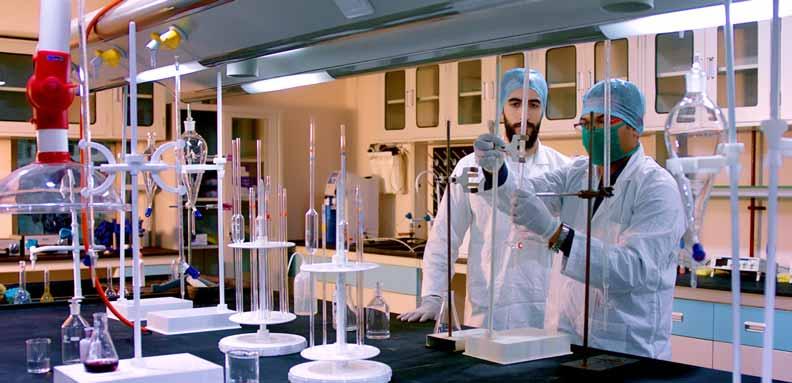
infrastructure like 3D printers and high performance computers and networks. Based on such capabilities, some of the leading private & deemed universities have been able to attract significant numbers of funded projects given out by CSIR and other government agencies.
Several noted private universities have also launched twinning programs with renowned universities in developed nations. Despite false starts by multiple universities multiple times, authentic twinning programs are likely to thrive, and a big difference in recent years is that the twinning is often bi-directional with overseas students equally eager to study in India.

UGC has recently come down heavily on some universities and edtech brands for promoting ‘study in India and get a foreign degree’ programs. The regulator has warned that such new age degrees won’t be recognized in India.
To combat the unregulated online degree menace, reputed institutions like Delhi University are bringing currency kind of authenticity to degree certificates, along with including mothers’ names in the degree records, as is the practice in tax and bank records.
Apart from mutual twinning programs, several private universities in the health sciences sector are now experiencing heightened interest from foreign students to enrol for ayurvedic degree programs like BAMS in India.
On the technical education front, AICTE has recently allowed its affiliated institutes to offer BTech/BE degree programs like evening courses to working professionals. This will go a long way in a scenario where students need to take up smaller jobs initially to support themselves and their families, after their degrees or diplomas, even while they are enabled to complete their graduate degrees in engineering to pursue better jobs.
Greater Noida, Uttar Pradesh, based Galgotias University is widening its lead with peer universities despite its young age, under the visionary leadership of its dynamic young leader Dr. Dhruv Galgotia. Achieving NAAC A+ accreditation in its first cycle, the university offers a wide array of over 200 programs across 20 Schools, spanning Polytechnic, Undergraduate, Postgraduate, and PhD courses. Since its founding in 2011-12, Galgotias University has grown as a home to over 30,000 students, providing a world-class education and producing graduates poised for success in their chosen careers via industryleading placements and startup incubation. Consistently ranked among India’s top universities, Galgotias University is also recognized for its innovative approach, achieving and maintaining the Highest 4-Star Rating by Central Government’s Ministry of Education Innovation Cell (MIC), for promoting Innovation and Start-ups in Campus, for the last four years. The GU campus has incubated over 200 startups till now, thereby encouraging the entrepreneurial spirit among its students. Also a research powerhouse, Galgotias University has recently secured 3rd rank among the top 10 Indian applicants for patents from academic institutions and universities, and it has also secured a place in the top 5 Indian applicants for patents in the field of information technology. The university’s research contributions include over 14,000+ publications and 2000+ patents, and GU is also a leader in funded research. Recently, in tune with the global healthcare field’s momentous move towards preventive medicine, the university strengthened its health sciences foray by inaugurating its Diet Out Patient Department (OPD). GU also continues to be a leader in meaningful industry tieups with recent examples being its tie-up with Telecom Sector Skill Council (TSSC) and Huawei to establish a Telecom Centre of Excellence, and its tie-up with Delta IT Networks & HP for an AI Learning Lab. However, the most momentous among such recent moves have been the setting up of an iOS Development Centre at Galgotias University in partnership with tech leviathan Apple. Galgotias Group too is forging ahead under Dr. Dhruv Galgotia’s leadership, as an inspiration to its students and faculty, with a mega development plan in Ayodhya that includes a a 5-star hotel, a well-equipped hospital, a sprawling mall, and a mega housing project.


Greg Joswiak was in India earlier this year and was amazed at the app development abilities of students at Galgotias University. As Senior VicePresident for Worldwide Marketing at Apple, Greg had come visiting to inaugurate the iOS Development Centre at Galgotias University.
A cutting-edge facility, the iOS Development Centre at Galgotias University is established in collaboration with Apple and is primarily designed to foster innovation and nurture the next generation of iOS developers from India. The Centre is equipped with unique and formidable infrastructure including 100 iMacs, providing Galgotias students with the opportunity to engage in hands-on learning and practical applications of iOS development principles.
During the inauguration, Greg engaged with the students of Galgotias University, discussing their startup journeys and exchanging ideas on entrepreneurship. The iOS Development Centre at GU has hit the ground running as Galgotias students are already working on a variety of innovative apps that leverage the capabilities of the iOS ecosystem including their first two apps, Sakhi and VibroPlay.
While Sakhi is an app designed to aid women in tracking their menstrual cycles and addressing the related health concerns, VibroPlay is a music learning app specifically created for individuals
At just 32 years of age, Dr. Dhruv Galgotia is the youngest CEO in the Indian formal education sector.

with hearing impairments, allowing them to experience music through vibrations.
The iOS Development Centre at Galgotias University represents a significant milestone in the university’s journey, under the visionary leadership of its CEO Dr. Dhruv Galgotia, towards

providing world-class education and fostering innovation in technology education.
While the Centre is seen as a hub for cutting-edge innovation, by encouraging a learning environment that integrates the latest advancements in iOS technology, the university also decided on establishing this Centre as the learnings from the iOS Development Centre are expected to have a farreaching impact beyond the boundaries of the Centre, specifically in the teaching-learning pedagogy of the entire university.
Going even beyond, the Centre is expected to make significant societal contributions too. For instance, the Sakhi and VibroPlay apps reflect the Centre’s focus on creating practical applications that can have a positive impact on society. The iOS Development Centre provides students with the resources and guidance needed to turn their innovative ideas into socially relevant applications.
Some of the key features of the Sakhi

app include Menstrual Cycle Tracking, Health Tips, Reminders and Safety Features. It allows women to track their menstrual cycles, predict ovulation, and monitor related health patterns, even while offering health tips and reminders for important health check-ups and medication. Its safety features include alerting contacts in case of emergencies.
Sakhi aims to address the various concerns related to women’s health and empowerment, contributing to the fulfilment of UN’s Sustainable Development Goal 5 (SDG 5) which calls for gender equality and the elimination of violence against women. The development of Sakhi reflects Galgotias University’s commitment to social responsibility and the practical applications of technology for societal benefit.
The iOS Development Centre is by no way a singular achievement at Galgotias University. This leading private university based at Greater Noida in UP is already noted for its superior academic, research and industry-ready


facilities. The university has already established several Centres of Excellence that focus on interdisciplinary research, providing state-of-the-art equipment and resources.
These Centres of Excellence include the School of Computing Science & Engineering Labs, the Central Instrumentation Facility (CIF), the 3D Printing and Fabrication Lab, Healthcare Research Facilities, Applied Sciences and Humanities Labs and Animal Research Facility Centre, to name just a few.
The School of Computing Science & Engineering Labs at Galgotias University includes over 30 state-of-the-art general
and domain-specific labs, with many of them sponsored by industry leaders including IBM, Cisco, Sun Microsystems, Red Hat, and Microsoft. These labs support research in areas like computer networks, software engineering, digital image processing, wireless sensor networks, cloud computing, big data, machine learning, deep learning, robotic process automation, and edge computing.
In tune with the times, Galgotias University has also tied up with Delta IT Networks & IT giant HP to commission its AI Learning Lab by investing Rs 10 Crore in acquiring specialised AI Machines from HP.
GU has also recently partnered with the SEASONAL MAGAZINE
Telecom Sector Skill Council (TSSC) and the global telecom giant Huawei to establish a Telecom Centre of Excellence which will bring the latest telecom technologies and international standard skilling programs in the telecom sector to the Galgotias campus. In the field of healthcare research, Galgotias University has three state-ofthe-art laboratories for student training in optometry, and for providing advanced instrumentation and equipment for practical exercises. The University which already has a noted foray into healthcare and medical research is expected to go full steam ahead in medical education and public healthcare facilities in the years to come.
Recently, in tune with the global healthcare field’s momentous move towards preventive medicine, the university strengthened its health sciences foray by inaugurating its Diet Out Patient Department (OPD), while it
Dr. Dhruv Galgotia appreciates PM Narendra Modi for encouraging young CEOs under the 'Champions of Change' program of NITI Ayog, which he feels will take India on the path to development.
is already home to a Physiotherapy OPD.
A Centre of Excellence at Galgotias University that deserves a special mention is its Central Instrumentation Facility. The CIF is a state-of-the-art facility designed to support multidisciplinary research in emerging domains such as material sciences, biosensors, organic photovoltaics, medical & drug research and other such sunrise fields.
The CIF houses many sophisticated and general instruments essential for research in basic and applied sciences including Fourier Transform Infrared (FTIR) used for chemical analysis, quality control, quantifications, and verification of raw materials; and High Pressure Liquid Chromatography (HPLC) with Manual Injector that is used to analyse advanced traditional small molecule drugs and supports various research areas like medicinal chemistry, bioanalysis, drug metabolism, and pharmacokinetics.
The Central Instrumentation Facility at Galgotias University also has a UVVisible Spectrophotometer with UVProbe which is used for measuring the intensity of light as a function of the colour of light and is usually seen only in clinical laboratories for quantitative analyses, kinetics, spectrum scanning, and multiple components of DNA/ protein testing.
The CIF is an integral part of Galgotias


University’s commitment to excellence in teaching and research, providing faculty, research scholars, and students with the necessary tools to carry out globally competitive research. It was established under the visionary leadership of CEO Dhruv Galgotia with a mission to enrich resources on a shared basis to promote research and development across various science disciplines.
The CIF aims to strengthen the technical infrastructure for advanced research, organise short-term courses and workshops on the use and applications of various spectroscopic and analytical techniques, develop new measurements & analytical methods, and also allows outside users to utilise its high-tech equipment for their research and testing purposes on a nominal payment basis. Such extensive Centres of Excellence and other such matching infrastructure forms the bedrock for Galgotias University’s significant achievements in the research and development field within a short span of time. Also a leader in funded research, it has received funding for over 1,135 projects, which facilitates advanced research and development across various disciplines. Galgotias University has recently secured 3rd rank among the top 10 Indian applicants for patents from academic institutions and universities, with a notable 1089 patent applications being filed as reported by the Office of the Controller General of Patents for the year 2022-23. Additionally, Galgotias

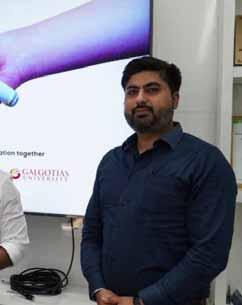
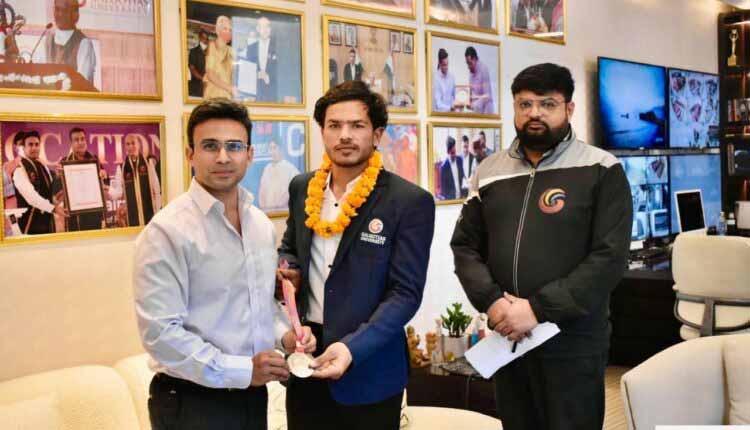
University stands out for its leadership in academic innovation too, with 209 applications filed, and it has secured a place in the top 5 Indian applicants for patents in the field of information technology, highlighting its role as a leader in academic innovation.
The university has so far delivered a strong research output with over 14,000 publications and significant citation numbers, reflecting the impactful research conducted by its faculty and students. The university’s research scholars have won over 2000 intellectual property rights, including patents, and the university also takes care to protect the intellectual contributions of its community.
Galgotias University offers a wide range of Doctor of Philosophy (PhD) programs across various disciplines including in most streams of Engineering, most of the Basic Sciences, Mathematics, Biochemistry, Microbiology, Health Sciences like Optometry, Pharmacy & Physiotherapy, Clinical Research, Medical Biotechnology, Clinical Nutrition & Dietetics, Psychology, and Humanities & Social Sciences including English, Political Science, Economics, Sociology, Law, Management, Mass Communication, Education, Computer Applications, and Agriculture.
The eligibility criteria for admission to

the Ph.D. programs generally include a Master’s degree or a professional degree equivalent to a Master’s degree with at least 55% marks in aggregate or a CGPA of 6.0. Candidates with a valid score in NET/JRF/SLET/GATE/Teacher Fellowship Holder or those who have passed M.Phil are exempted from the Ph.D. Entrance Test (PET).
Due to its leadership in industry-ready infrastructure and research capabilities, the university continues to set new records in nationally benchmarked admissions. This year, Galgotias University set a new record by receiving 7.26 lakh applications through the Common University Entrance Test (CUET) for its undergraduate and postgraduate programs.
This is a formidable achievement for Galgotias University considering its youngness and size. The university has been rapidly growing in student intake too with the last Convocation Ceremony for the Class of 2023, witnessing a total of 3,906 students graduating.
Under CEO Dhruv Galgotia’s vision, the university has gone to extraordinary lengths to create one of the most impressive faculty among comparable peer institutions. Thanks to it, GU today boasts of a diverse and accomplished faculty, with members hailing from prestigious institutions across the USA, Europe, and Asia.
This impressive panel of accomplished
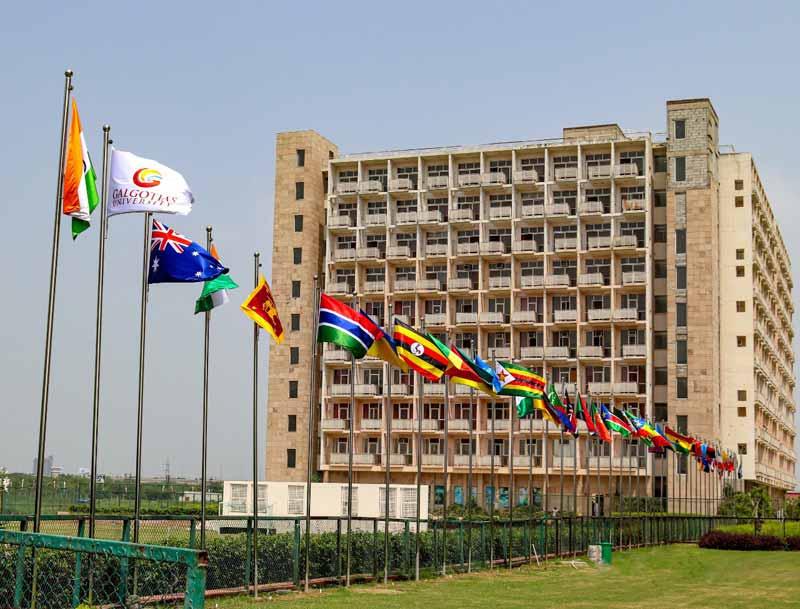
teachers includes both seasoned academics and experienced industry professionals who are committed to providing high-quality education and fostering research excellence. They are actively involved in research and scholarly publications, contributing to thought leadership in their respective fields.
In its undergraduate and postgraduate departments Galgotias University offers a wide range of courses across various disciplines. The university is structured as 20 distinct schools offering undergraduate and postgraduate programs.
Galgotias University’s School of Computing Science & Engineering offers programs like B.Tech and M.Tech in various specialisations, whereas its School of Computer Applications & Technology offers courses like BCA and MCA.
Its School of Engineering offers B.Tech and M.Tech, in all conventional and innovative engineering branches, while Galgotias’ School of Business provides
BBA, MBA, and other business-related programs.
GU’s School of Law offers LLB, LLM, and integrated law programs and its School of Liberal Education includes a variety of arts and humanities courses. Other GU Schools include School of Media & Communication Studies, School of Hospitality & Tourism and the School of Biological & Life Sciences.
Galgotias University also offers several other programs including in architecture, design, commerce, pharmacy and more, with degrees including B.Sc (Hons), B.Des, B.A (Hons), B.Pharm, BPT, and more.
Galgotias University has taken care to balance rigorous admission standards with flexibility for students coming from various backgrounds.Towards this, GU accepts a variety of entrance exams for admission into its various programs. These include Galgotias’ own department specific tests as well as nationally benchmarked tests.
GU’s own entrances are heavily attended and includes Galgotias Engineering Entrance Exam (GEEE) for B.Tech admissions, Galgotias University Management Aptitude Test (GUMAT) for MBA admissions,
Galgotias University Law School Admission Test (GULSAT) for admission to Integrated BA LLB (Hons.) and BBA LLB (Hons.) and the Ph.D. Entrance Test (PET).
Additionally, Galgotias University accepts students who have scored high in national entrance tests like Common Universities Entrance Test (CUET), Joint Entrance Examination (JEE Main), Common Management Admission Test (CMAT), Management Aptitude Test (MAT), Graduate Management Admission Test (GMAT), NMAT by GMAC, National Aptitude Test in Architecture (NATA), Common Law Admission Test (CLAT) and Law School Admission Test (LSAT) for LLB (Hons.) and LLM.

Chancellor Dr. Mariazeena Johnson has made the performance of Sathyabama Institute of Science & Technology (SIST) a tour-de-force in India’s higher education sector on all counts that matter. The Chennai based Category1 deemed-to-be university is second to none whether it is futuristic courses, scholarships for the meritorious underprivileged students, campus placements, basic & applied research, patents, technology transfers, startup incubation, international tie-ups, centres of excellence and lots more. Also a philanthropist with a heart of gold, Dr. Mariazeena is using her Anbu Foundation and her friendship with top-notch social influencers including actresses Nayanthara and Samantha Ruth Prabhu to bring about societal change and women’s empowerment.

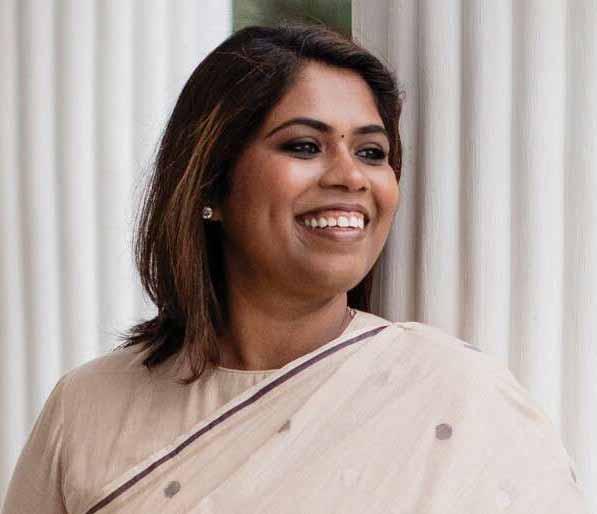
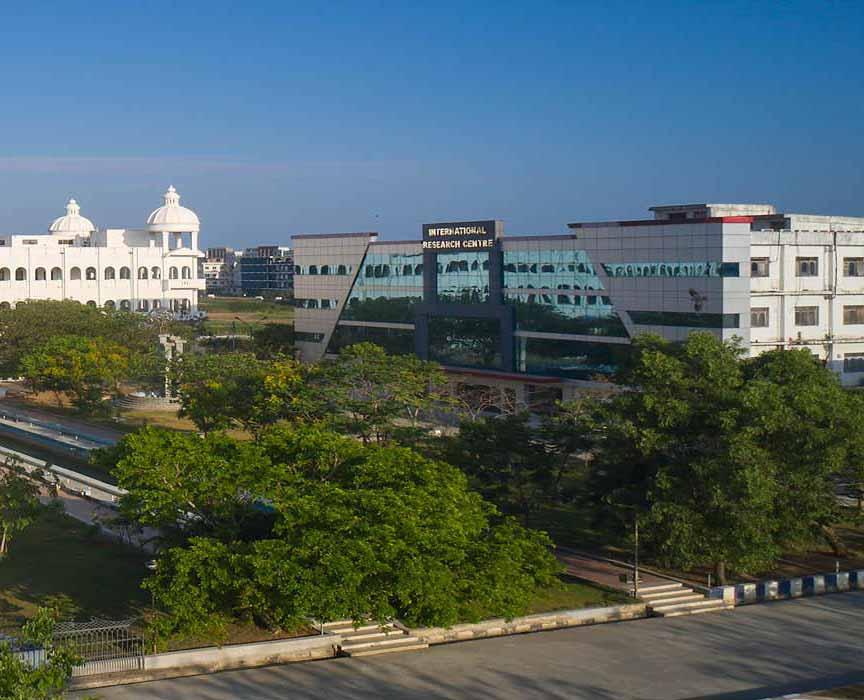
SATHYABAMA'S CAMPUS RECRUITERS THIS YEAR INCLUDE HEAVYWEIGHTS LIKE ACCENTURE, TCS, COGNIZANT, DELOITTE, HITACHI, HCL, NATWEST, BNY MELLON AND MORE SUCH MNCS AND DOMESTIC MAJORS.
Dr. MARIAZEENA JOHNSON, ChancellorEven while most universities are facing a lull in placements, Chennai based deemed to be university, Sathyabama Institute of Science & Technology (SIST) has recently achieved 2,545 job offers from 312 companies for over 93% of its students who had applied for campus placements.
Among the recruiters are heavyweights like Accenture, Cognizant, Deloitte, Hitachi, HCL, TCS, Natwest, DevRev, Tredence Analytics, Virtusa , Tejas Network, Athena Health, JSW Steels, Sona Comstar, UnoMinda, Genpact, BNY Mellon, Godrej and Zoho. Also, among this year’s recruiters are 72 new companies, proving that Sathyabama continues to enlarge its footprint in India Inc, even in this tough year for placements.
Sathyabama’s success in placements was directly due to this deemed university’s various Centres of Excellence working in close collaboration with several global majors including ServiceNow and PwC that resulted in bridging the industryacademia gap effectively.
Demonstrating its mindshare across India and the world, this year’s recruited students from Sathyabama hail from 32 states & union territories of India and 15 countries across the globe. The highest salary package this year also remained strong at nearly Rs 50 lakhs, while average package was Rs 5.40 lakhs.
The power of Sathyabama’s sectorleading full scholarship program was also on display, as 115 students who had studied on full scholarship were among those successfully placed this
 Dr. MARIE JOHNSON, President
Dr. MARIE JOHNSON, President
year. In academic placements too, Sathyabama students proved their mettle with 15 final-year students getting qualified for MTech through the national level Graduate Aptitude Test in Engineering (GATE).
Sathyabama is a powerhouse in research with the output of its research scholars attracting over 13,0000 citations in Scopus, and over 6,500 in Web of Science.
Around 300 students also obtained admissions in various prestigious national and international universities for their higher studies. Proving that the Sathyabama campus is also among the best for physically challenged students, five visually challenged students from Sathyabama have been admitted to programmes in the prestigious Indian Institutes of Management (IIMs).
Unknown to many in the public, one factor that has been helping this university’s students in garnering top placements year after year has been the contributions of its vibrant Sathyabama Alumni Association (SAA). Sathyabama was established as Sathyabama Engineering College in 1988, and had
achieved deemed university status in 2001 as Sathyabama Institute of Science & Technology.
During these nearly four decades of existence, Sathyabama has produced global leaders, scientists, entrepreneurs, social entrepreneurs, artists, writers, and managers, across India and the world. The Sathyabama Alumni Association (SAA) brings all these outstanding people and their collective wealth of knowledge and experience together on a single platform.
While the Sathyabama Alumni Association has been contributing to the university and the community around it in diverse ways, one of the most effective means has been how the Sathyabama Alumni have been helping the university get connected with their employers. Most such companies have ended up as regular recruiters from Sathyabama, as they realise the efforts that the university and SAA have been
taking in grooming the newer batches of students.
For instance, there are specific and formal programs that Sathyabama has created in collaboration with SAA like Alumni Lecture Series, Alumni Mentorship Program and Mock Interviews by Alumni, that directly help the current batches of students by guiding them to placement and career success.
Alumni with proven expertise and indepth knowledge in specific domains have been made part of Sathyabama’s Board of Studies, so that they have a voice in including futuristic subjects in Sathyabama’s frequently updated and contemporary curriculum.
Sathyabama openly acknowledges and celebrates its Alumni for not only their contribution to the university, but to their domain and society at large. Such Alumni who have made prominent contributions in the fields of academics, research, corporate careers, entrepreneurship, and social development are honoured with the ‘Distinguished Alumni Award’ every year.
Earlier in the last academic year, Sathyabama got a shot in its arm when the higher education regulator of India, the University Grants Commission (UGC) elevated the institution to the status of a Category 1 Deemed to Be University with greater autonomy to start departments, courses and off campus centres without prior approval.
To put this achievement in perspective, the venerable public sector institution Madras University that was established way back in 1857 also obtained Category 1 status in the same year as Sathyabama, that is, in 2023. The Category 1 status is usually bestowed on institutions that have achieved a 3.51 or above score by the National Assessment and Accreditation Council (NAAC).
Sathyabama Institute of Science and Technology can be proud that it could attain the coveted Category 1 status within 23 years of it getting recognised
Sathyabama excels in applied research, technology transfers and startup incubation with 850+ patents filed, 525+ patents published, 300+ patents granted, and 22+ technology transfers.
as a deemed to be university. The institution has also been ranked in the 51st position by the National Institutional Ranking Framework (NIRF) 2023 and this has been the eighth consecutive year that Sathyabama has been ranked among the Top 100 Universities of India.
Sathyabama is a powerhouse in research with the output of its research scholars attracting over 13,0000 citations in the leading citation database Scopus, and over 6,500 in the other leading database, Web of Science, which is a great achievement for a university in the private sector that is yet to celebrate its 25th anniversary as a university.
This deemed university’s researchers
also excel in applied research as well as development of intellectual property, with over 850 patents filed, over 525 patents published and 300 plus patents granted to the institution and its researchers. Also a leader in startup incubation, Sathyabama has so far made 22 plus technology transfers to entrepreneurs, startups and companies.
Sathyabama is increasingly strengthening its health science courses, and this initiative is backed by the Sathyabama Hospital that provides healthcare services across multiple departments including general medicine, general surgery, cardiology, endocrinology, diabetology, obstetrics & gynaecology, paediatrics, dental sciences, dermatology, ENT, orthopaedics, ophthalmology, urology, and nephrology.
Recently, Sathyabama Institute of Science and Technology launched a new initiative on women empowerment titled Anbu with an aim to safeguard women’s health. The launch event, which saw actress Samantha Ruth Prabhu as the guest of honour, also saw Chancellor Dr. Mariazeena Johnson distributing Sathyabama’s Anbu health cards to women staff, girl students and women in public life.
Women and girl students can use the

Anbu health card to access various health examinations typically needed by women such as mammograms, blood tests, screenings for diabetes, eye care, oral health, abdominal scans, and haemoglobin counts at Sathyabama Hospital.
Sathyabama’s health science courses are spread across seven of its departments which includes its School of Pharmacy, School of Nursing, School of Paramedical Sciences, School of Dental Sciences, School of Allied Health Sciences, School of Science & Humanities that houses its BSc and PhD in Psychology, and its School of Bio & Chemical Engineering that houses its BSc, BTech, MTech & PhD courses in biotechnology among other courses in Biochemistry, Biomedical, Microbiology, Bioinformatics etc.
However, Sathyabama’s largest student
offers 7 BE
in Computer Science & Engineering with 7 futuristic specialisationsAI, IoT, Data Science, AI & Robotics, AI & ML, Blockchain, and Cybersecurity.
contingents continue to be in its earliest engineering departments, including its School of Computing, School of Electrical & Electronics, School of Mechanical, and School of Building & Environment. Sathyabama’s School of Management Studies, School of Law and School of Science & Humanities are also noted for their long-standing excellence and relatively large number of courses and student intakes.
Among all these departments, Sathyabama’s School of Computing deserves a special mention as it offers seven Bachelor of Engineering (BE) Degrees in Computer Science & Engineering with seven futuristic specialisations - Artificial Intelligence (AI), Internet of Things (IoT), Data Science (DS), AI & Robotics, AI & Machine Language (ML), Blockchain Technology and Cybersecurity.
During last year’s Convocation, which was also its 32nd, Sathyabama Institute of Science and Technology had awarded over 4,000 degrees. It was AICTE Chairman TG Sitharam who awarded degrees to 3,504 graduates, 551 postgraduates, and 104 PhD scholars. 7 students also received their Diploma in Pharmacy, while 47 students from all streams also received gold medals for their performance in academics and in various fields.

Chancellor Dr. Mariazeena Johnson is not only a towering edupreneur but a noted philanthropist with a heart of gold. She is the moving force behind Anbu Foundation which is also affiliated with Sathyabama Institute of Science & technology (SIST). The Foundation extends additional support to scholarship recipients by providing food and hostel accommodations.
Under her guidance, SIST has also introduced the Anbu Scholarship Scheme to support underprivileged students in pursuing their higher education. The scheme grants scholarships to students identified by NGOs, as well as children of Indian defence personnel, destitute women and war widows, children of prison inmates, and meritorious wards of Sathyabama’s non-teaching staff. The screening process evaluates factors such as family background,
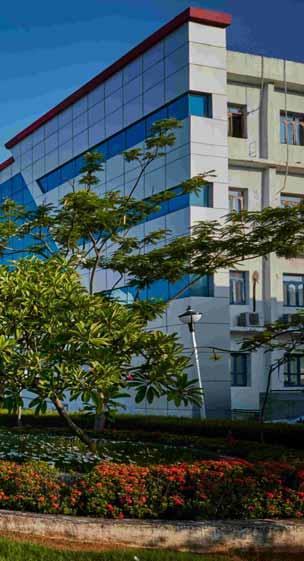

performance in qualifying exams, and a test conducted by the institution before awarding the scholarship.
Earlier in the year, Sathyabama launched the ‘Madugai’ scheme for girl students in government run schools, under which health & hygiene kits are distributed to them. Madugai means strength in Tamil language and the scheme has won the heart of leading actress and entrepreneur Nayanthara who has since then been acting as the institution’s brand ambassador.
A champion of women’s empowerment, Dr. Mariazeena Johnson feels that it is more difficult for women to come up in life, but that they can surely come up on the strength of their resolve and society’s support. As someone who walks her talk, she has made sure that
Sathyabama is strengthening its health science courses, and this initiative is backed by the Sathyabama Hospital that provides healthcare services across multiple departments.
85% of administrative posts and 70% of faculty positions in Sathyabama are occupied by women. Under her guidance, Sathyabama has also adopted several village schools in the suburbs of Chennai, in a concerted effort to bring them up on all counts.
Mysuru headquartered leading deemed-to-be university, JSS Academy of Higher Education & Research (JSSAHER) is taking giant strides to push innovation in everything it does. From nationally recognized research labs to world renowned faculty members to playing host to coveted international scientific conferences to startup incubation to constant upgradation of infrastructure and facilities, JSSAHER is not leaving a stone unturned in its quest to stay ahead of the curve among health and life science universities in the country. JSSAHER’s visionary leadership includes JSS Mahavidyapeetha’s Head Sri Shivarathri Deshikendra Swamiji of Suttur Mutt, JSS Mahavidyapeetha’s Executive Secretary C.G. Betsurmath, JSSAHER’s Pro-Chancellor Dr. B. Suresh and its Vice-chancellor Dr. Surinder Singh.


With over 1,61,000 members, the American College of Physicians (ACP) is undoubtedly the largest medical-specialty organization in the United States. In other words, it is the largest and the most esteemed professional group of doctors who are internists or physicians who are practitioners of internal medicine or general medicine as it is commonly called today. Research students even in India, even if they have not heard of ACP, must have surely heard of the weekly research publication, ‘Annals of Internal Medicine’, which is ACP’s core research journal, the highest ranked & cited journal for internal medicine, and regarded as one of the top five medical journals worldwide.
ACP selects and awards internal medicine specialists for a few key achievements in their work annually. In 2023 too ACP announced these annual awards, and the American College of Physicians Distinguished Mentor Award in 2023 was bagged by Dr. M Suresh Babu, who serves as Professor of Medicine, JSS Medical College & Hospital, JSSAHER, Mysuru. While giving away the award, the American College of Physicians noted that this award is in recognition of his outstanding mentorship

in the field of clinical medicine. Dr. Suresh Babu is also a Fellow of the Royal College of Physicians, Edinburgh, UK. With such distinguished practitioners and researchers in its fold, it is no wonder that both JSSAHER’s medical college and hospital have been thriving as leaders in research and clinical practice.
Recently, the JSS Medical College also received a special recognition from the Government of India’s Indian Council of Medical Research (ICMR). This happened when JSS Medical College’s Centre of Excellence in Molecular Biology and Regenerative Medicine (CEMR)
at the Department of Biochemistry was recently recognised by ICMR as an ICMR-Collaborating Centre of Excellence (CCoE). While bestowing this recognition on CEMR for a period of five years, ICMR noted that this is in consideration of its scientific accomplishments.
Dr. Prashanth Vishwanath, JSSAHER’s Dean of Research and Dr. Akila Prashanth, Professor and Head of the Department of Biochemistry, received the recognition from Dr. Rajiv Bahlat, the Director General of ICMR, at the ICMR headquarters in New Delhi recently. As an ICMR-CCoE, this JSSAHER unit will engage in extensive

cooperation with ICMR to develop guidelines, undertake multi-centric projects, and enhance capacity building efforts in the country. The available resources in such centers will be shared with other centers for the purpose of student training, R&D, and capacity development for enhancing the national research talent pool for advancing medical research in India.
A prime advantage of studying at JSSAHER is the unique exposure students get from the depth and breadth of the international conferences it hosts. A recent example was the HEAL-BioTec 2023 hosted by the JSS School Of Life Sciences. This three-day International Conference on ‘One

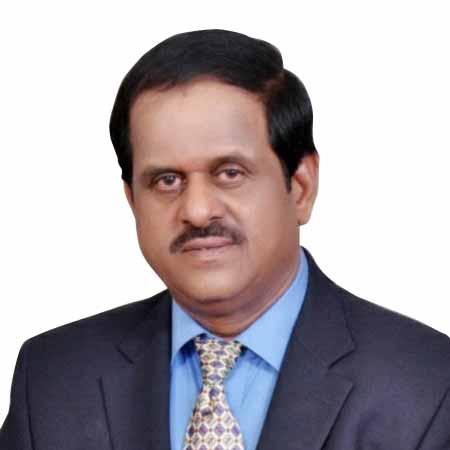
Health: Biotechnology as a Catalyst for Sustainable Development was organized by the Department of Biotechnology and Bioinformatics, JSSAHER. This conference was funded by three Indian Government bodies including the Department of Science and Technology (DST), the Science and Engineering Research Board (DST-SERB) and the Department of Biotechnology (DBT), and it achieved its objective to discuss and further the new concept of ‘One Health’ which serves as a catalyst for achieving the Sustainable Development Goals (SDGs) by 2030.
Also included in the G20 agenda, the ‘One Health’ approach aims to improve disease management by bringing together health, food and environmental scientists as well as policy specialists from different parts of the globe, to help in achieving SDGs by this decade’s end. It was a never before opportunity for JSSAHER students, faculty members, and researchers to interact with world renowned experts in these contributing domains and gain integrated knowledge about the One Health approach. Sanjay Kumar Varshney, Advisor & Head, International Collaborations, Department of Science & Technology (DST), Govt. of India, was the chief guest and delivered the keynote address that described how Artificial Intelligence is speeding up clinical trials among other aspects.
Dr. Hans Jorgensen, Professor, University of Copenhagen, Denmark, who was the guest of honor, delivered a plenary lecture, with another plenary lecture by Dr. Anil Kaul from Oklahoma, USA. Other eminent scientists who delivered invited lectures

include Dr. Jung-Hyun Kim (South Korea), Dr. Raj Kumar (Boston, USA), Dr. Claus Bang-Berthelsen (Denmark), Dr. S. Pradeep Kumar of Google and Dr. Manju Bansal from IISc. Apart from research scholars, faculty members and students, the attendees included leading industrialists from concerned sectors. Hosted both physically and in
online mode, the mega conference benefitted at least 500 students directly, apart from the thousands of viewers who tuned into it from the world over.
During the last two quarters itself, the students, faculty and researchers of JSSAHER have been blessed with the university hosting several such events. These included an international conference on the genetics & epigenetics of cancer, a two day fair on forensic and investigative science, a live hysteroscopy workshop for gynecologists & postgraduate students, an international conclave on the occurrence and prevention of tuberculosis, and a rally to educate people on the importance of adult immunization especially for the elderly and high risk patients, conducted by JSSAHER’s Adult Immunization and Travel Medicine Center.
JSSAHER also continued to fortify its already impressive facilities and infrastructure in its core School of Life Sciences at Mysuru. During the last quarter, the deemed university launched the School’s


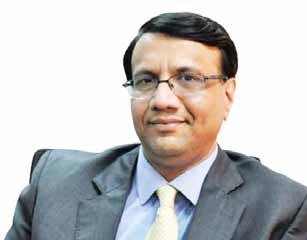
new Lecture Hall Complex with the inauguration done by Karnataka’s Minister for Medical Education, Sharan Prakash Patil. The School of Life Sciences offers 14 post graduate programs, 6 undergraduate programs and 2 diploma courses

in the regular stream, as well as several courses in the Open & Distance Learning (ODL) mode.
During the occasion, Minister Sharan Prakash Patil also inaugurated the University’s incubation facility named ‘Sparkle Cine’ for boosting the start-up initiatives by students, faculty and interested entrepreneurs. Sparkle Cine has been active for some quarters now, but now it gets its own infrastructure and facilities, towards fulfilling its stated aim of furthering the start-up culture in the university by translating educational excellence into actionable ideas for entrepreneurship and innovations. Also launched during the event was a new pharmaceutical chemistry lab.
Over the almost one and a half decade of its existence, JSSAHER has steadily improved not only on the quality front, but on the volume of graduates and postgraduates it grooms in each batch. Last quarter was witness to this phenomenon once again, during the fourteenth convocation of JSSAHER. All together, 2,546 graduands were awarded their undergraduate, postgraduate & diplomas this year, apart from 49 candidates who were awarded PhD degrees. Chairman of UGC Prof. Mamidala Jagadesh Kumar was the chief guest who delivered the convocation address and gave away medals to 55 academic toppers.
Dr. Surinder Singh, Vice Chancellor JSS Academy of Higher Education & ResearchNITTE DEEMED UNIVERSITY
Under the visionary leadership of its Founder Chancellor N Vinaya Hegde, Pro Chancellors Vishal Hegde and Prof. Dr. Shantharam Shetty, and Vice Chancellor Dr MS Moodithaya, Nitte Deemed-tobe University has been ranked among India’s Top 100 universities for the 5th consecutive year in the NIRF rankings, and it has also jumped 10 ranks this year to the 65th position. Two of Nitte’s eminent scientists Dr Indrani Karunasagar and Dr Iddya Karunasagar have also bagged top ranks of 11 and 13 respectively in the field of microbiology by Research.com. Nitte alumni like Vidya Kamath Pailodi and Dr. Saritha Arunkumar have brought global accolades to the university recently, while on the national stage two of Nitte students have won the 1st and 6th rank in the Joint CSIR-UGC NET Examination under the Life Sciences category.
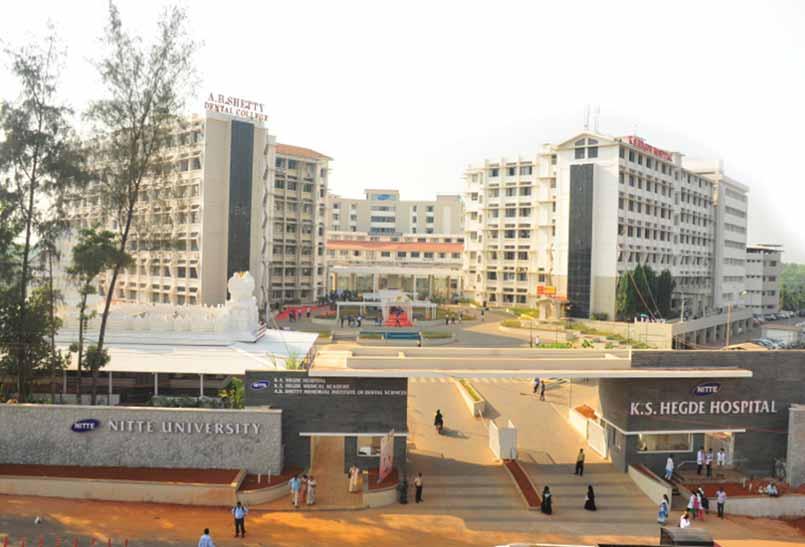

iebel Scholars program needs no introduction among cutting-edge universities in the world and their graduate students and startup entrepreneurs. Established by the Thomas and Stacey Siebel Foundation in 2000, the Siebel Scholars program selects around 90 graduate students each year from some of the finest universities in the world to be a Siebel Scholar. So far only 1800 Siebel Scholars have been selected and they form an elite club of researchers, entrepreneurs, engineers, scientists and top rung of managers.
There are only 16 universities from which Siebel Scholars have so far been selected and they include prestigious names like Harvard, Stanford, John Hopkins, MIT, Princeton, UC Berkeley, University of Chicago, Wharton, and University of Illinois Urbana-Champaign, which is also incidentally the alma mater of billionaire businessman Thomas Siebel, one of the world’s most successful tech entrepreneurs who founded Siebel Systems which was later acquired by Oracle.
Recently, the Siebel Scholars Foundation announced its 2024 Class of Siebel Scholars, honouring 83 exceptional graduate students from top universities around the world in the fields of bioengineering, business, energy science, and computer science. Five Computer Science students from the University of Illinois Urbana-Champaign were named to this year’s class, and among them is Vidya Kamath Pailodi, a second-year graduate student working with Professor George Chacko to explore the field of Computational Scientometrics.
Before arriving at the University of Illinois Urbana-Champaign, Vidya worked as a software engineer in the thermotechnology department at Robert Bosch Engineering and Business Solutions in Bengaluru, India. This was shortly after Vidya graduated as a Gold Medalist in ECE from the NMAM Institute of Technology in Nitte, India where she earned an undergraduate degree in Electronics and Communication Engineering.
Vidya’s achievement is something about
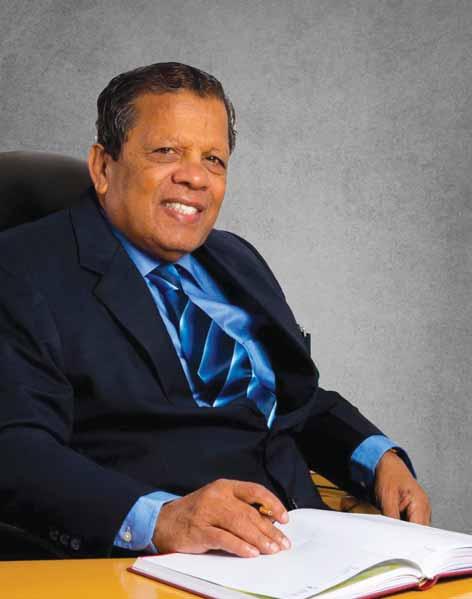
which Nitte Deemed University can be proud of as Nitte Mahalinga Adyanthaya Memorial Institute of Technology (NMAMIT) is a constituent engineering college of Nitte Deemed University. This achievement is all the more impressive as 4 out of the 5 students from University of Illinois who won this prestigious scholarship are from India, from prestigious institutions including IIT Indore, IIIT Hyderabad & Manipal Institute of Technology.
Vidya’s and Nitte Group’s achievement in this regard is by no means a one-off phenomenon on the world stage. Recently, Dr. Saritha Arunkumar who holds the position of IBM’s Public Cloud World Wide Technical Leader in Security, in the United Kingdom, won the prestigious award, The Princess Royal Silver Medal, often called the
N Vinaya Hegde ChancellorOscars of Engineering.
Bestowed by the United Kingdom’s Royal Academy of Engineering, the award was presented to Dr. Saritha by none other than HRH Princess Anne, Sister of King Charles, in London. The award was in recognition of this leading cyber-security expert’s invaluable and critical contributions to shaping security in emerging areas such as the cloud, blockchain, and biometrics.
Earlier, Dr. Saritha has been recognised as an IBM Master Inventor, an IBM Super Hero, Financial Times' Top 100 BAME Technology Leaders Award, and The Inc Magazine’s Top 10 Business Women to Follow in 2022. Her achievement of winning the The Princess Royal Silver Medal is regarded as an achievement for India, and of course for Nitte Group as
Dr. Saritha had graduated from the NMAM Institute of Technology in 2000 as an Electronics & Communication Engineer, and was also the topper of her batch.
Vidya’s and Dr. Saritha’s education and grooming at NMAM Institute of Technology happened much before it became a constituent college of Nitte University. But this only goes on to add further sheen to the farsighted vision and care accorded by Nitte Educational Trust led by its Chancellor N Vinaya Hegde, years or even decades before it became a formal university.
Nitte Deemed University is a part of Nitte Group run by Nitte Education Trust, which was founded in 1979 by Justice Kowdoor Sadananda Hegde, former Chief Justice of the Supreme Court and former Speaker of the Lok Sabha. Offering education in diverse areas of learning, Nitte today offers a total of 130+ programs including medicine, engineering, management, hospitality, allied health sciences, dentistry, pharmacy, nursing, physiotherapy, speech and audiology, media & communication and architecture. The Trust has established 40+ institutions spread across three campuses at Nitte, Mangalore and Bangalore and has over 20,000+ students and 4500+ faculty in its campuses.
Equipping its students for outperformance continues even to this day at Nitte University. In the national level Joint CSIR-UGC National Eligibility


Test (NET) exam conducted a few months back, a total of 78,168 students had appeared under the Life Sciences category. NET exam is conducted to determine the eligibility for Junior Research Fellowship (JRF) and Lectureship (LS) / Assistant Professor post in Indian universities and colleges.
Among these over 78,000 students who appeared under the life sciences category, there were students from the Nitte University Centre for Science Education & Research (NUCSER) too.
And guess who won the national level top ranks? Twin sisters, Rhea Kishore and Reena Kishore, MSc Biomedical Science students at NUCSER, achieved the 1st
and the 6th Rank nationally! It was an incredible performance by these Nitte students as Rhea scored a total percentile of 99.94 whereas Reena scored 99.66. Both of them were mentored at the university by Dr. Akshath US, Scientist G-II, and Dr. Anirban Chakraborty, Professor & Director of NUCSER, and the achievement of these twin sisters has become another proud moment in these recent times for Nitte University.
Such mentoring in both the academic and leadership aspects is a culture that permeates the entire university starting from the very top rungs. Vice Chancellor
 Vishal Hegde Pro Chancellor
Vishal Hegde Pro Chancellor
N Vinaya Hegde and Pro Chancellor Vishal Hegde have been known to intervene for the student community at every appropriate forum. Such an instance happened during the university’s 2022 convocation, when Vinaya Hegde requested UGC Chairman and Chief Guest Prof. Mamidala Jagadesh Kumar to upgrade the Mechanical, Civil and Electrical Engineering courses with components from computing and electronics to make them relevant at the changing workplace.
NMAMIT that produced winners like Vidya and Dr. Saritha today offers both conventional and advanced engineering branches like Artificial Intelligence & Machine Learning, Robotics & AI, Biotechnology, Civil, Computer & Communication, Electrical & Electronics, Electronics & Communication, Information Science, Mechanical Engineering etc.
Pursuit of values is another dimension where the Nitte University leaders excel, starting right from the Chancellor. Recently, pioneering orthopaedic
 Dr MS Moodithaya Vice Chancellor
Dr MS Moodithaya Vice Chancellor
surgeon and Pro Chancellor of Nitte University, Prof. Dr. Shantharam Shetty, who was the Chief Guest of OASISCON 2023, a 3-day Conference Of Orthopaedic Associations Of Six South Indian States Hosted By Karnataka Orthopaedic Association, delivered such a value based lesson for fellow orthopaedic surgeons.
Said the Nitte Pro Chancellor, “During those years (when I started my practice),


there were only three to four orthopaedics, including myself, in Mangaluru, while at present, there are over 200 orthopaedics in the city, which is a tremendous growth in this field. Yes, we all want to earn money but always remember to serve your patient first and then think of money. Practice for need and not for greed,” added Dr Shantharam Shetty.
Startup incubation is another domain where Nitte University is starting to make impressive gains. Recently, an innovative betel leaf tea bag product was developed by young startup entrepreneur Sandeep Eshanya with the support of Nitte University’s DST Technology Enabling Center and Dr Mamatha BS, an expert in food technology and faculty at Nitte University Center for Science Education and Research.
While the nutritional value of betel leaf is noteworthy, being rich in fibre, vitamins A, B, C and minerals like calcium, iron and potassium, it was an arduous and time-consuming process that took several iterations of laboratory studies and consumer acceptance trials to ready a process for preparing tea bags from betel leaves without losing nutrients, medicinal properties and in the original flavour as well as incorporating additional flavours as per user preference.
Entrepreneur Sandeep Eshanya was all praise for Nitte University’s support, when he said, “NITTE University boosted my confidence when I pitched my idea. They have been a constant support to convert my dream into reality. I have now sent samples to 10 countries such as Sri Lanka, United States, UK and many more.”
There is more to Nitte University’s support for such startup entrepreneurs than in product development. Under the guidance of Prof. Dr Iddya Karunasagar, Advisor - Research and Patents, at Nitte University, the process of producing the betel leaf tea bags has been protected by a shared patent, and Nitte University has authorised Eshanya Beverages, the concerned start-up to commercialise the technology through an agreement, so that the product is effectively made available in the Indian and overseas markets.
SEASONAL MAGAZINE
Nitte Deemed University also has a robust research program that offers Fulltime and Part time Ph.D Course in the faculties of Medicine (including PreClinical, Para-Clinical & Clinical), Dentistry, Pharmacy, Physiotherapy, Allied Health Science, Nursing, Biological Sciences, Speech & Hearing, Engineering, Commerce & Management, Applied Sciences, Business Administration and Humanities.
Meritorious Full Time candidates receive Nitte PhD Fellowships of Rs. 20,000/- per month as per the University’s guidelines. Nitte takes the quality element of its PhD program quite seriously, and there is an impressive lineup of Research Guides, and the selection of candidates is based on a national-level entrance test, statement of purpose and personal interview.
Nitte University organises various workshops and seminars to bring industry experts right into the campus. A similar workshop to mark the World Food Safety Day was organised by Nitte DST Technology Enabling Center in association with CII, FSSAI & KCCI, and was moderated by Nitte faculty Dr. Indrani Karunasagar. She emphasised the need to understand the basis for food safety standards and the best practices that food business operators from farm to plate need to follow to comply with the standards. The discussions covered improving food hygiene and food safety in all segments of the food industry including street vendors, quality control, certifications and accreditations required by food

testing laboratories.
Nitte is also forever forging meaningful tie-ups with select industry majors in training and certification for the employability of its students. A few months back it forged such a tie-up with upGrad Campus, the higher education arm of upGrad, one of Asia’s largest integrated career skilling, workforce development & placement companies.Under this collaboration, UpGrad Campus will support Nitte BTech students with one of the hottest coding skills today - Full Stack Development (FSD) - so that they are adept with the tech requirements of the modern day workplace.
Spread over a period of 4 years, the FSD specialisation begins in the first year integrated within the university
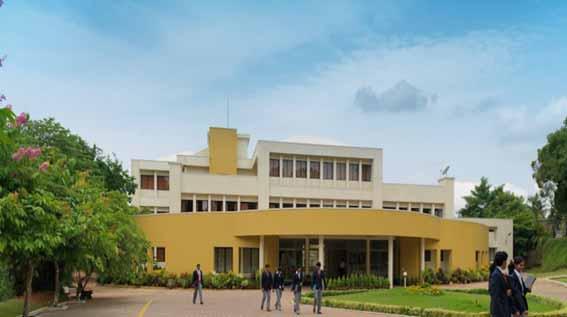
curriculum and has been designed for engineering aspirants who aim to build a career in the Information Technology domain. It will cover around 1400 hours of learning content with over 300 live sessions, 11 projects and case studies, in sync with the B.Tech syllabus to ensure learners get higher experiential learning.
It will also encourage live & interactive faculty engagements, alumni networking, and industry-specific sessions/simulations to enhance the overall subject understanding to further enable them with the expertise required to succeed in the said industry. The tieup is aimed at making Nitte students stand out from the lakhs of Engineering students in India.
Management education is another domain where Nitte Deemed University is a force to reckon with, thanks to its longstanding experience through its Justice KS Hegde Institute of Management (JKSHIM). This highly ranked MBA institute recently welcomed its 26th batch of MBA students, with a unique value-add. A guest of honour at the event was former alumni Sajan Murali, who is now the CEO of Turtle Wax Media Ltd. Sajan belongs to the 1999-2001 batch of MBA at JKSHIM, and called upon the current batch of MBA aspirants to focus on imbibing the soft skills.
JKSHIM which recently celebrated its Silver Jubilee, had Dr. Debashis Chatterjee, Director, IIM Kozhikode, delivering the Silver Jubilee lecture on the theme of ‘Leadership Challenges'. Noting that Nitte Founder Justice KS Hegde was a visionary with values, Dr. Chatterjee said, “Principle and value centred leadership is the need of the hour. Life has no meaning without values and principles. Integrity is the hallmark of life. These virtues need to be imbibed during schooling and college days.”
Bengaluru based Nitte Meenakshi Institute of Technology (NMIT), which is promoted by Nitte Education Trust, but which is not technically part of Nitte Deemed University yet, recently hosted its 1st International IEEE conference on ‘Networks, Multimedia and Information Technology’, NMITCON 2023.
Sponsored by the AICTE, the conference brought together experts and enthusiasts from across the domain of information technology, including AICTE Chairman Dr. T. G. Sitharaman, Dr. David Camacho from the Technical University Of Madrid, Spain, and Ms. Namrata Dutta, Senior IT Auditor, from Mumbai, whose keynote addresses at the event was a great source of inspiration to the participants. Authors from countries including the USA, the UK, and Germany, and also from premier Institutions like IISc., IITs, IIITs,

and NITs presented their papers at this Conference.
Also marking the occasion was the inauguration of the AICTE-IDEA Lab by Dr. T. G. Sitharaman. The focus of the lab is to encourage students to apply Science, Technology, Engineering, and Mathematics (STEM) fundamentals on ideas for enhanced hands-on experience and even product development. The AICTE has also sanctioned Rs.15 lakh to NMIT to help establish the lab.
Nitte Institute of Communication (NICO), another constituent college of Nitte Deemed University, is also acing its game above peers with international industry certifications. Recently, it received the prestigious Godox Certification under which Godox, a world leader in professional and studio
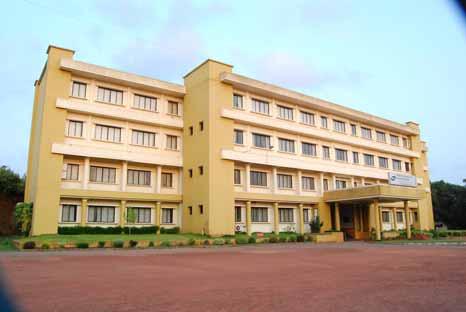
quality lighting, will conduct workshops on lighting for students, where they will learn from the Godox Team about latest lighting techniques and practices. With this tie-up, NICO has become India’s Only Godox Certified Training Centre.
Besides the Godox partnership, NICO also hosts workshops by experts in photography, feature writing, video editing, VFX, and short filmmaking. These workshops give students exposure to real-world challenges and opportunities in the media industry.
Besides offering five comprehensive programs in media and communication, the institution also organises the Nitte International Film Festival (NIFF), which is one among the few student-managed film festivals in the country. Nitte communication students thus get an opportunity to interact with filmmakers, technicians, actors, cinematographers, scriptwriters who participate in the festival, which is so characteristic of the way Nitte Deemed University grooms all its students.
With such initiatives across the campus and all its constituent colleges, it is no wonder really that MNCs and large Indian corporates have been placing students from Nitte Campus. These include renowned names like Mercedes Benz, Toyota Kirloskar Motors, Hitachi, ABB Power Grids, Juniper Networks, Intel, Novo Nordisk, L&T Technology Services, Syngene International, JSW Group, Prestige Construction, JK Cement etc.
SEASONAL MAGAZINE
ICFAI Group, especially its flagships IFHE & IBS Hyderabad, stand a notch above its peers when it comes to nurturing its students and faculty to be global winners. This has been so even when the faculty and students have been from non-IIT & non-IIM backgrounds, with the best example of this phenomenon being the global case study legend, the Late Prof. Debapratim Purkayastha, who not only rubbed shoulders with his peers from renowned institutions including Harvard, INSEAD & IMD, but edged past them to be the top ranked business case study writer in the world for 8 years running. Death could snatch him tragically by age 44, but not before IFHE & Prof. Debapratim ensured that a formidable team of



six business case writers have emerged in the Global Top 50 list of case writers. The distinct advantage for IBS Hyderabad students is that these globally award winning cases are taught by their own authors who are their own teachers! This nurturing attitude at IFHE traces its roots to its founder Late NJ Yasaswy, who was a national first rank holder for five national level exams including his CA & ICWA intermediates and finals! Even more importantly, Yasaswy was an edupreneur par excellence who fought indomitable challenges from both India and abroad to establish the ICFAI Group. This flame is today carried on by leaders including its Chancellor and renowned economist Dr. C Rangarajan, Vice Chancellor Prof. (Dr.) LS Ganesh, IBS Hyderabad’s Director Prof. Venu Gopal Rao KS, its Dean Prof. (Dr.) Sindhuja PN, and other top ranking academic leaders of IFHE.
One of the most often raised concerns regarding college graduates and post graduates, be it in India or abroad, is the huge disconnect between what they master in the classroom and what is actually happening in the real world companies where they hope to be employed as soon as they pass out.
Different professions tackle this in different ways, like how hospitals manage it through house surgency for fresh doctors, or how engineering industries tackle it through training and probation periods. But there are certain professions where this disconnect is too great to be bridged easily.
The best example for such a challenging career is business management, where textbook level knowledge is woefully inadequate to equip MBA aspirants for what really awaits them at their dynamic workplaces driven by rapid innovation and tech led paradigm shifts.
Perhaps the only way this academicindustry disconnect can be bridged in B-schools is by including ample real world case studies in the curriculum. And that is what the best B-schools, right from Harvard and Stanford, to our own IIMs and other leading institutions do.
To cite some dynamic examples with buzzing or turnaround companies across the world like IKEA or Fitbit or X/Twitter or Blackberry, there are numerous challenges faced by them currently that have evolved into top ranking business case studies.
IKEA is in an ethical dilemma while expanding in Russia, Fitbit is leveraging its X/Twitter data for business insights, and Blackberry has been plotting a turnaround plan to regain relevance in the smartphone market which it once ruled.
All these dynamic case studies are
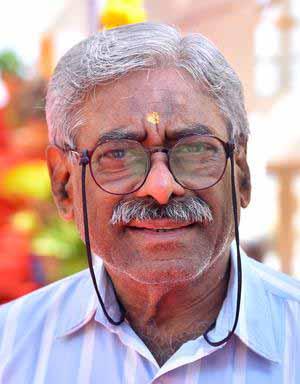
current bestsellers and taught across leading B-schools across the world including in Hyderabad based ICFAI Business School (IBS), a constituent of the ICFAI Foundation for Higher Education, a leading deemed-to-be university.
But IBS students have a distinct advantage while these case studies are being taught, as they have been written by their own teacher, V Namratha Prasad, Assistant Professor, ICFAI Business School, who also teaches them the same! These case studies won for Prof. Namratha, the 34th rank last year in the case study ranking by UK based The Case Centre, arguably the biggest repository of global business case studies.
Prof. Namratha is not an exception
at IBS, nor are her students. In fact, IBS Bangalore Director Prof. GV Muralidhara is a prolific and award winning business case study author, who won the 16th rank in last year’s rankings by The Case Centre, for his case studies on post-Brexit Britain’s prospects, on the Chinese fintech major CreditEase’s financial inclusion strategies, as well as for his contributions for the IKEA-Russia case study from IBS itself.
Another stalwart from the ICFAI Business School stable who made his mark in last year’s Case Centre rankings was Prof. Sanjib Dutta, Associate Dean in charge of the Case Research Centre at IBS. Prof. Dutta bagged last year’s 12th bestselling rank from The Case Centre, UK, for his case studies including those on

the digital transformation underway at Starbucks, Motorola’s China leadership strategies and Nokia’s fall from leadership and how it is fighting back for a market share.
The IBS case writers in last year’s Top 50 authors rubbed shoulders with research scholars from prestigious global B-schools including Harvard Business School, INSEAD, Columbia Business School, IMD, Newcastle University, Penn State Harrisburg, Georgetown University, University of

Virginia, University of Bath, London Business School, HEC Paris and many others.
In fact, apart from Harvard that produced maximum winners, followed by INSEAD and IMD, the maximum number of top ranked case writers last year were from IBS, Hyderabad. Apart from the names already discussed, the IBS Scholars included the 11th rank winner Prof. Jitesh Nair whose case studies were on Microsoft & Automattic, the 7th rank winner Prof. Syeda Maseeha Qumer whose case studies were on HBO’s Game of Thrones, Body Shop & ZTE Corporation, and the 2nd rank winner Prof. Indu Perepu whose case studies were on Airbnb’s Design Thinking, and on international clothing brands Under Armour and Zara.
While these case studies by IBS scholars will greatly enrich the global case study approach at thousands of B-schools across the world, IBS students are greatly fortunate to learn these case studies from their own authors, who happen to be their teachers too!
But they will greatly miss that one case study author who began this revolution at IBS, and elevated IBS’ stature globally among all B-schools.

He is none other than the one and only Prof. Debapratim Purkayastha, the former Director of ICFAI Business School. But the legend lives on, as despite his unfortunate and untimely passing away due to Covid in May 2021, the UK based Case Centre selected Prof. Debapratim himself as last year’s No. 1 rank holder among all best selling case study authors!
And it couldn’t be otherwise, as before his untimely death at age 44, Prof. Debapratim had proven himself as one of the most prolific case writers, with The Case Centre, UK, database itself holding 531 cases authored or co-authored by him. By the time of his death, his cases had been used at 1,595 B-schools across
Prof. Venu Gopal Rao K S Director, ICFAI Business School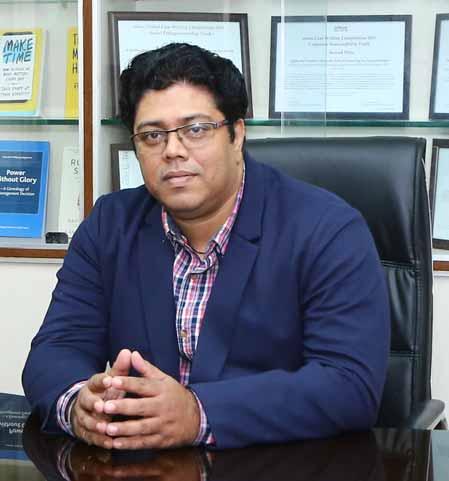
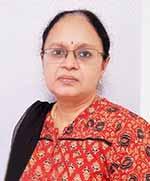
95 countries to teach over 2,33,900 students. And ever since The Case Centre began publishing its Top Bestselling Case Authors list in 2016, the first rank has been won by this IBS scholar, year after year.
But two other factors truly differentiate the success of Prof. Debapratim and IBS. One is that both this unique professor and this unique university made sure that his skill in
 Debapratim Purkayastha
Debapratim Purkayastha



case writing doesn’t end with him, but is taught to other emerging scholars too. That is how IBS dominated last year’s list too, just behind global giants Harvard, INSEAD & IMD, with 6 top ranking scholars apart from Prof. Debapratim in the global Top 50 authors.
Secondly, this whole success story of ICFAI Group with regard to its ICFAI Business School (IBS), was narrated
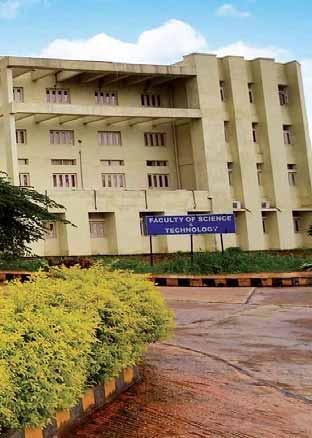
to illustrate a unique trait displayed by this higher education group from its day one to until now, and is designed so as to perpetuate endlessly. This unique trait - of talent identification and development - in both faculty and students permeates across ICFAI Group’s 11 Universities, 9 B-Schools, 7 Tech Schools and 9 Law Schools across the country.
And this talent nurturing trait that originated from ICFAI Founder, Late NJ Yasaswy, has grown from strength to strength over the past 35+ years, and continues across the Group and in its flagship deemed university IFHE Hyderabad under its Chancellor and renowned economist Dr. C Rangarajan, Vice Chancellor Prof. (Dr.) LS Ganesh, IBS Hyderabad’s Director Prof. Venu Gopal Rao KS, its Dean Prof. (Dr.) Sindhuja PN, and other top ranking academic leaders of IFHE. Apart from ICFAI Business School, IFHE is home to its engineering and technology school, IcfaiTech School, ICFAI School of Architecture and ICFAI Law School.
In a higher education system where educational labels like IITs, IIMs, IISc, ISB etc are deemed more important than their actual achievements, ICFAI Group and especially the ICFAI Foundation for Higher Education (IFHE) has excelled in its own, by attracting and nurturing non-IIT / nonIIM talents too to global levels of

 Syeda Maseeha Qumer
Jitesh NairSanjib Dutta
GV Muralidhara
V Namratha Prasad
Syeda Maseeha Qumer
Jitesh NairSanjib Dutta
GV Muralidhara
V Namratha Prasad
excellence. Forget IITs/IIMs, this deemed university and its businessschool have made global academic winners out of people coming from non-academic or industrial background.
The best example for this phenomenon is Late Prof. Debapratim Purkayastha himself. Coming from a non-IIT / non-IIM background, with his degree from Gauhati University, MBA from Utkal University & PhD from KITS, Debapratim was basically from an industries background, especially in sales, sales force management and product management at pharma companies including Torrent, Zydus Cadila, Themis & Hetero, before switching over to academia at IBS Hyderabad.
And there was no looking back, as his new home - IBS - instantly recognized his innate talents and assigned him to the then fledgling initiative of case study creation. It was a perfect match between a talented human being and a nurturing organisation, and that is how Debapratim Purkayastha from an industries background became Prof. Debapratim Purkayastha, a globally renowned thinker and case study author.
Under IFHE’s nurturing culture, Prof. Debapratim could also train and inculcate other leaders who carry on this IBS flame in industry interactions and case studies to greater heights. Prof. Debapratim led over 70 inspirational case method workshops for research scholars, faculty members, and business executives; and he worked in various leadership roles for renowned case study journals including Case Folio, Case Focus, Case Research Journal and Case Journal. Even the week before his unfortunate demise, he was leading a case workshop at Jaipuria Institute of Management, Jaipur.
This unique trait of IFHE & IBS, which Prof. Debapratim imbibed perfectly, speaks for itself today in the achievements of leaders like
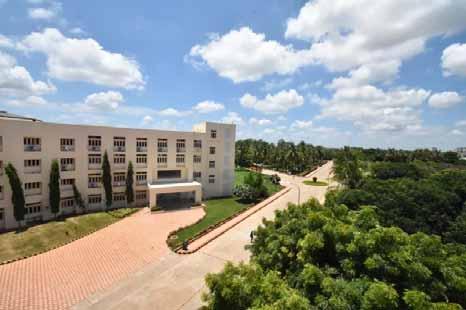
Professors GV Muralidhara, Sanjib Dutta, Indu Perepu, Syeda Maseeha Qumer, Jitesh Nair, V Namratha Prasad and many others. It couldn’t have been otherwise as they have great role models in ICFAI’s all past and present leaders including its Founder, Chancellor & Vice Chancellor.
ICFAI Group Founder Late NJ Yasaswy was the first rank holder for five exams - BCom, CA Inter, CA Final, ICWA Inter & ICWA Final, apart from being the recipient of the Basu Foundation Award for the Best Student of the Year from both The Institute of Cost and Works Accountants of India and The Institute of Chartered Accountants of India. Also a legendary edupreneur, Yasaswy fought seemingly indomitable challenges from both India and abroad to establish this sprawling higher education empire.
IFHE Chancellor Dr. C. Rangarajan needs no introduction in India, as this renowned economist and thought leader has served as the Governor of the Reserve Bank of India, as the Governor of Andhra Pradesh State, as the Chairman of Economic Advisory Council to Prime Minister Dr. Manmohan Singh, as Chairman of the Twelfth Finance Commission and as Member of Parliament in Rajya Sabha.
Though IFHE has nurtured great winners out of non-IIT & non-IIM faculty and students, this nurturing attitude has invariably resulted in attracting top talent from these premier engineering and management institutes of India that are globally renowned. The topmost leader that exemplifies this phenomenon now at IFHE is none other than its current Vice Chancellor, the one and only Prof. (Dr.) LS Ganesh, endearingly known as Prof. LSG wherever he has led the academics.
Before assuming the role of VC at IFHE on September 1 2022, Prof. LSG was Professor, Department of Management Studies, and Dean, of IIT Madras. With over three decades of experience spanning teaching, research, and intellectual services, Prof. LSG has also been a Visiting Professor at University of Passau in Germany, IIM Bangalore, IIM Kozhikode, ISB Hyderabad and NIT Trichy, among others. Prof. LSG has over the years also lent his expertise to international organisations including World Bank and UNDP, and national organisations including ISRO, MHRD, AICTE, NBA, CII, FICCI, and MMA.
With such leaders with deep industry connect at the helm, there is no wonder IFHE has been bettering its standing in academics, research and placements year after year.

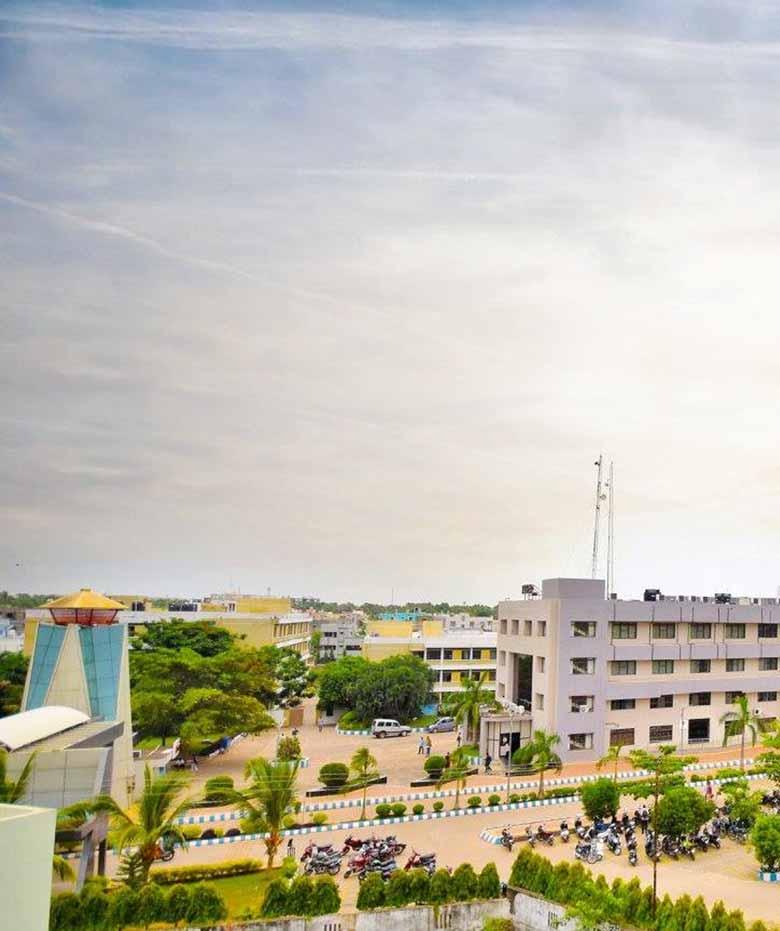

THE ODISHA BASED SOA DEEMED-TO-BE-UNIVERSITY HAS BEEN EXCELLING IN PLACEMENTS YEAR AFTER YEAR, MOVING UP THE RUNGS BY WAY OF BOTH QUANTITY AND QUALITY OF JOB OFFERS FROM LEADING CORPORATES, AS WELL AS ACHIEVING BIG IN INCUBATING ADMIRABLE STUDENT STARTUPS.


magine students impressing dignitaries like Dharmendra Pradhan, India’s Minister for Education, Subhas Sarkar, Minister of State for Education, and Rajeev Chandrasekhar, Minister of State for Skill Development & Entrepreneurship, with their startup projects. That is what four student groups of Odisha’s Siksha ‘O’ Anusandhan (SOA) deemed-to-be university achieved recently. These teams belonging to SOA’s faculty of engineering, the Institute of Technical Education and Research (ITER), had created four startups - Wedmist Technology, Twinverse Technology, Let’s Drive & Extrava Study Tours - that won the appreciation of Education Minister Dharmendra Pradhan. The event was an elite one, the recent sixday Future of Work Exhibition held on the sidelines of the G20 Education Working Group meeting which was held at the CSIR Institute of Minerals and Materials Technology in Bhubaneswar. The first startup Wedmist Technology’s flagship product serves hyper-local service providers through Artificial Intelligence
(AI) while Twinverse Technology focuses on diverse areas including archaeology, tourism etc that are among Odisha’s strengths as well as in novel product designing. The third startup Let’s Drive is working on creating unique employment opportunities in the use of electric vehicles, while the fourth one Extrava Study Tours focuses on enhancing the workplace skills of people seeking employment using innovative means. Apart from the Union Ministers, other
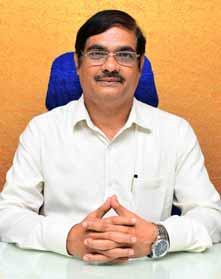
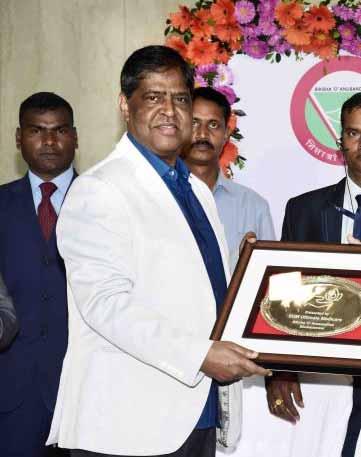
top dignitaries who visited the SOA startups stall included Prof TG Sitharam, Chairman of AICTE, K Sanjaya Murthy, Secretary, Higher Education in the Ministry of Education, Prof Anil Sahasrabudhe, Chairman, EC, NAAC and Dr Nirmaljeet Singh Kalsi, Chairman, National Council for Vocational Education and Training. While student startups are inspiring for all, they directly empower and enable only a fewer number of students, and SOA has bigger initiatives that enable almost all of its 15,000 strong student community. One such recent event was an industrial interactive workshop conducted by SOA in Bhubaneswar on the topic ‘Recent Developments and Challenges in Core Industries’. The workshop focused on subjects like emerging areas of renewable energy, future challenges of work, workforce and workplace in manufacturing industries, challenges which obstruct the improvement of core industries, and opportunities for smart manufacturing and application of data science, Artificial Intelligence (AI) and Machine Learning (ML) in Industries. The workshop was organised by the Department of Mechanical Engineering of the SOA’s Institute of Technical Education and Research (ITER), and featured industry
 Prof. Pradipta Kumar Nanda. Vice Chancellor
Prof. Pradipta Kumar Nanda. Vice Chancellor

experts from Brahmani River Pellets Ltd, CTTC, Sunstone Solar Solutions, Sree Metaliks, and GMR Power Plant as the resource persons who discussed the dynamically changing career prospects of engineering students. The experts detailed the need for preparing graduates in the field of science and technology by inculcating various emerging skill sets required by the industry. With such empowering programs it is no wonder really that SOA has not only ended the need for Odisha based students to go outside the state for higher education, but is also attracting students from all over India and some pockets of the world. This deemed university has been excelling

in placements year after year, moving up the rungs by way of both quantity and quality of job offers from leading corporates. SOA is accredited by NAAC with ‘A++’ grade and is in its 3rd cycle, and is ranked Internationally by QS and THE World University Rankings. In MHRD’s NIRF India Rankings 2022, it is 16th in the University Category, 27th in the Engineering Category, 18th in the Medical Category, 10th in the Dental Category, 9th in the Law Category and

45th in the Research Category. SOA has also been granted the Category-I Graded Autonomy Status by UGC, Government of India. The sprawling SOA campus in the capital city of Odisha is ranked 3rd nationally for being most clean under the Government’s Swachh Campus initiative. The brainchild of Prof. (Dr.) Manojranjan Nayak, who serves as the President of SOA, this deemed university follows national and international standards in pedagogy and the quality of its teaching learning systems and processes. For instance, SOA follows the Outcome Based Education (OBE) framework and has several NBA and ICAR accredited programs. SOA is also home to the NABH accredited SUM Hospital and an NABL accredited Diagnostics Laboratory. SOA is professionally led by a team of academicians led by Prof. (Dr) Amit Banerjee as Chancellor; Prof. (Dr.) Pradipta Kumar Nanda as Vice Chancellor; Prof. (Dr.) Bibhuti Bhusan Pradhan as Pro Vice-Chancellor; and Prof. (Dr.) Sitikantha Mishra also as Pro Vice-Chancellor.

Imagine a higher education institution in India that brings together faculty from over 50 countries. No, not visiting or part-time faculty, but full-time faculty. A campus where students themselves come from 70+ countries. This deemed university in the National Capital Region - Delhi (NCR-Delhi) has also forged collaborations with leading institutions in 70+ countries so far to enable a truly international learning experience. With multiple
engagements spanning over the world, this university based in Sonipat, Haryana, has collaborations with 400+ leading institutions worldwide. No wonder then that when the Government of India’s Ministry of Education chose a creamy layer of universities to be ‘Institutions of Eminence’ in 2020, O.P. Jindal Global (JGU) was a natural choice. Today, JGU offers a variety of programmes to cater to the diverse needs of Indian and overseas students.
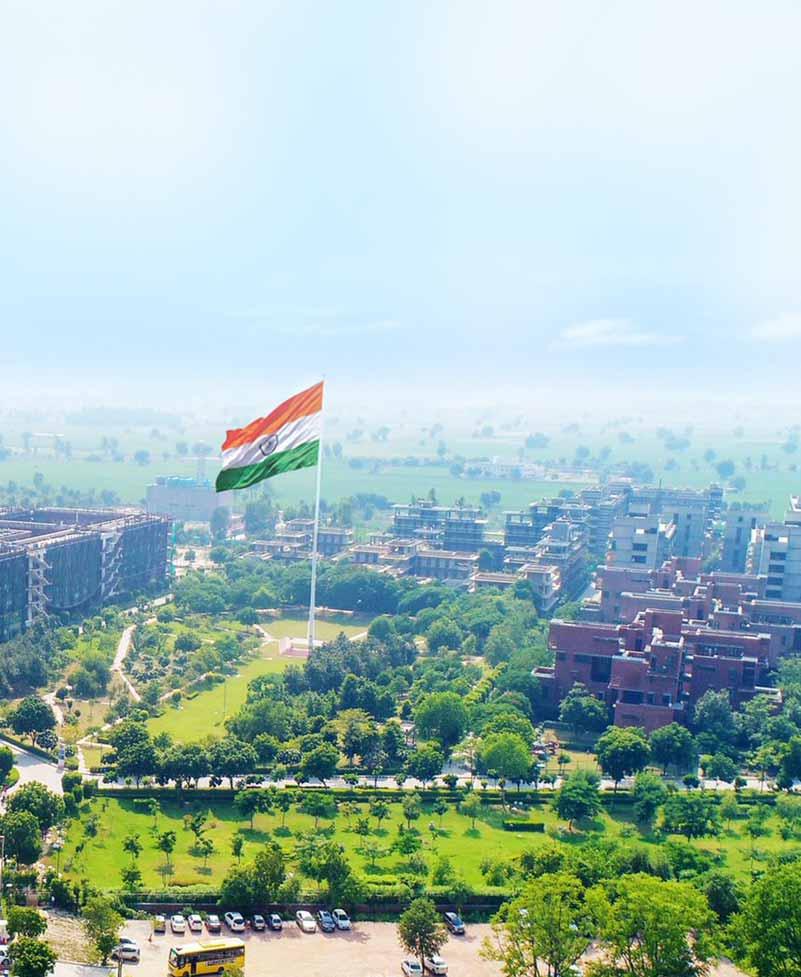
With over 45+ programmes available, including 30+ undergraduate programmes, 15+ postgraduate programmes, and doctoral programmes, JGU with its 12 Schools, 3 Research Institutes, 2 major Research Initiatives and 60+ Interdisciplinary Research Centres, is a force to reckon with in most domains, even on a global stage. JGU has unique institutions like the Jindal Institute of Leadership Development and Executive Education (JILDEE) under its fold. JILDEE has had unparalleled success in providing quality training and education to student officers of India’s public and private sectors. Since its inception, JILDEE has trained over 6,000 student officers and conducted 250 programmes in collaboration with 12 universities across the country. Eminent educational
institutions like JGU will invariably have eminent leaders and academicians behind them, and JGU is no exception with its Founder & Chancellor, Mr. Naveen Jindal, former Member of Parliament, billionaire industrialist and philanthropist, and its Founding Vice Chancellor, Prof. (Dr.) C. Raj Kumar, a Rhodes Scholar, trained at both Oxford & Harvard and an accomplished legal scholar with nine books and over 200 publications to his credit. JGU's 12th Convocation Ceremony and Founder's Day was held recently, for which the Presidential Address was by Hon. Mrs. Justice BV Nagarathna, Judge, Supreme Court of India, and the Convocation Address was by Dr. Joanna Newman, MBE FRSA, Chief Executive & Secretary General, Association of Commonwealth Universities, UK.

uality is never an accident, and the emergence of O.P. Jindal Global University (JGU) proves it yet again. A non-profit, multidisciplinary and research oriented university founded in 2009, JGU was established as a philanthropic initiative of its Founding Chancellor, Mr. Naveen Jindal in memory of his father, Shri. OP Jindal, who was one of India’s pioneering industrialists. JGU maintains a 1:9 faculty-student ratio and appoints faculty members from India and different parts of the world with outstanding academic qualifications and experience.
Mr. Naveen Jindal, who was only 39 years old, when he decided to start a university, entrusted the job to an even younger scholar of eminence. The Founding Vice Chancellor of JGU, Prof. (Dr.) C. Raj Kumar, was appointed as VC at just 34 years, and conceived the idea of establishing India’s first Global University. With the visionary leadership and philanthropic support of Mr. Naveen Jindal, JGU was established in Sonipat, Haryana in 2009. Under this duo’s tireless leadership, within 10 years, JGU became one of the only 20 universities in India and the only nonSTEM university, to be declared as an ‘Institution of Eminence’ by the Government of India.
When it comes to global rankings, Quacquarelli Symonds (QS) is one of the world leaders and it has rightly recognized JGU under several categories. JGU is ranked as India’s Number 1 Private University in QS World University Rankings 2023, for the third year in a row. JGU has also

been recognised among the Top 150 universities globally under the age of 50 years by the QS Young University Rankings 2022 and among the Top 500 Universities as per the QS Graduate Employability Rankings 2022.
JGU has steadily grown in its 14 years of existence, to claim some impressive stats now. With 10,000+ students and 1100+ full time faculty members, studying and living on a fully residential campus, JGU has 12 renowned Schools, and a unique institute for Executive Education, the Jindal Institute of
 Mr. Naveen Jindal Founder Chancellor
Mr. Naveen Jindal Founder Chancellor
Leadership Development and Executive Education (JILDEE).
The two other institutes at JGU are the International Institute for Higher Education Research & Capacity Building (IIHEd) and the Jindal Institute of Behavioural Sciences (JIBS). The two research initiatives in the campus are Jindal Initiative on Research in IP and Competition, and the Jindal Centre for Social Innovation + Entrepreneurship.
Jindal Global Law School (JGLS) has been the flagship Global School of JGU. In April 2023, JGLS retained its position as the No. 1 Law School in India as per the QS World University Rankings by Subject 2023. JGLS is committed to provide global legal education to its students. To fulfil this objective, the curriculum and pedagogy are designed to give extensive exposure to domestic, international and comparative law courses. JGLS has also entered into collaborations, exchange programmes,
research partnerships and other forms of engagements and interactions with leading law schools, such as Harvard, Yale, NYU, Sydney, Keio and many others. Prof. (Dr) C. Raj Kumar is the Dean of JGLS, and it delivers undergraduate, postgraduate and doctoral level programmes.

Jindal Global Business School (JGBS) is a leading private business school in the country renowned for its premier education in business management, with research and industry partnerships as high priority areas. JGBS offers a multidisciplinary global business education to foster academic excellence through industry partnerships and global collaborations, and seeks to make an impact through its various undergraduate, postgraduate, integrated and doctoral level programmes, as well as executive education, research and consulting. A globally focused faculty deliver globally relevant courses and curriculum, strengthened with global research and collaborations. Prof. (Dr) Mayank Dhaundiyal is the Dean of JGBS.
Jindal School of International Affairs (JSIA), founded in 2011, is India’s first global policy school, and has remained as its foremost international affairs institution. JGU established this pioneering institute, as India’s rising economic and military strength must be complemented with a world class


international affairs and social sciences base that will generate and test theories and present a customised Indian variant of global studies. JSIA is enriched by its diverse faculty – comprising academics, scholars, researchers, social scientists, authors, practitioner lawyers and diplomats and other such eminent experts – drawn from both India and abroad. It is a matter of satisfaction that for many years running now, JSIA
students are regularly finding placement in reputed think tanks, MNCs, Media and PR groups, UN and multilateral bodies, diplomatic missions, NGOs, and other such organisations. Dr. Sreeram Sundar Chaulia is the Dean of JSIA, which offers undergraduate, postgraduate and doctoral level programmes.
Jindal School of Government and Public Policy (JSGP) is India's first public policy school and strives to keep that lead. JSGP equips its students to become public policy practitioners, capable of constructively shaping public policies that contribute to overall human development, empower marginalised and disadvantaged groups, and eliminate poverty. JSGP faculty use their theoretical knowledge and practical expertise to deliver a multidisciplinary
Prof. (Dr.) C. Raj Kumar, Vice Chancellor Prof. (Dr.) Sreeram S. Chaulia Dean, JSIA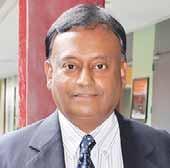
pedagogy, whereas JSGP students will create, expand and assimilate this knowledge to become future leaders, pursuing interdisciplinary practice. Prof. Sudarshan Ramaswamy is the Dean of JSGP, which delivers undergraduate, postgraduate and doctoral level programmes in public policy.
Founded in 2013, Jindal School of Liberal Arts and Humanities (JSLH), is India’s first transnational humanities school. The school provides an interdisciplinary liberal arts education of a global

standard. The aim is to educate young adults to become informed citizens of the world who are best equipped to solve the complex problems of our times, approaching them from multiple perspectives and with creativity. Faculty chosen from some of the best institutions across the world facilitate rigorous classroom study combined with experiential learning. Prof. Kathleen Modrowski is the Dean of JSLH, which delivers four different undergraduate programmes and a postgraduate diploma programme. One of the undergraduate programmes is a unique four-year dual degree programme with Rollins College, one of the top liberal arts colleges in the United States.

Jindal School of Journalism & Communication (JSJC) is the country's first global media school, with hands-on multimedia training, a rigorous writing programme in the interdisciplinary social sciences, making its students compatible with international media
schools or global media organisations or MNC communication departments, after the three BA (Hons.) programmes. JSJC provides a vibrant and scholarly setting for the study of journalism, film and new media studies. The JSJC studio with its extensive infrastructure including editing bays and sound labs enable the learning of practicals as well as theory making the students great storytellers in any global setting like radio, film, or TV production. Prof. Kishalay Bhattacharjee is the Dean of JSJC.
Jindal School of Banking & Finance (JSBF) is a research-led, future oriented and interdisciplinary global school focused on developing a new generation of leaders for the financial services industry. With the increased sophistication of corporations and demand for competitive, complex, fast and reliable financial services and solutions on a national and global scale, there is a need for highly trained recruits in the areas of technology, innovation, analytics, finance, accounting and banking. The fundamental strength of

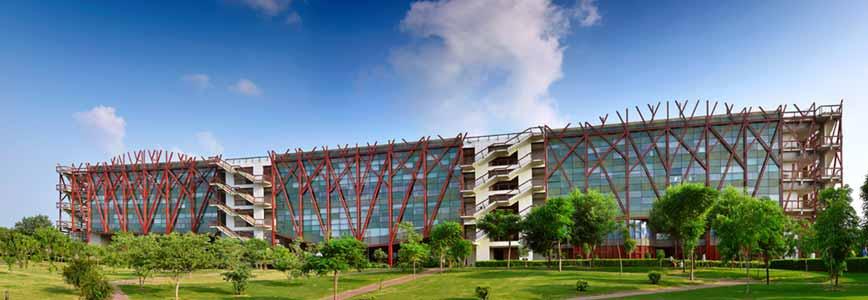 Prof. (Dr.) Dayanand Pandey Dean, JSBF
Prof. Kathleen A. Modrowski Dean, JSLH
Prof. Kishalay Bhattacharjee Dean, JSJC
Prof. (Dr.) Dayanand Pandey Dean, JSBF
Prof. Kathleen A. Modrowski Dean, JSLH
Prof. Kishalay Bhattacharjee Dean, JSJC
JSBF is its cutting edge curriculum and interdisciplinary education with global exposure. Prof. (Dr) Dayanand Pandey is the Dean of JSBF, which delivers undergraduate, postgraduate and doctoral level programmes in banking and finance related areas.
The Jindal School of Art and Architecture (JSAA) has a vision and strategy to emerge as one of the foremost schools of learning of the visual, material and the built environments. The school follows internationally accepted best practices of the academia and is supported by an acclaimed faculty. JSAA pursues research and innovative excellence that fosters interdisciplinary research initiatives cutting across academic programmes, thereby allowing students and faculty to actively engage in addressing the most pressing issues facing our world today. JSAA has ample facilities including a fabrication lab, a construction yard & lab, an environment research lab and a digital centre. JSAA is headed by its Dean, Prof. (Dr) Jaideep Chatterjee, and offers undergraduate and
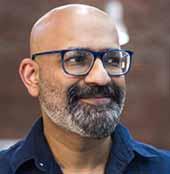

doctoral programmes as well as the unique Jindal Adelaide Architectural Pathway programme.
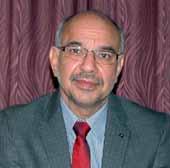
The Jindal School of Environment & Sustainability (JSES) is India’s first environment and sustainability school for undergraduates. JSES fosters curriculum, research, and collaborations of the highest standards, and with a global

perspective, through faculty drawn from around the world. The school provides interdisciplinary environment and sustainable development education through innovative teaching, impactdriven research, and practice-based engagement. The aim is to allow students to widen their horizon and develop skills required for solving the complex environment and sustainability challenges of our times. Interestingly, JSES offers two undergraduate programmes in Environment & Sustainable Development, as BA (Hons.) and BSc (Hons.) programmes. Prof. (Dr) Maharaj K. Pandit is the Dean of JSES.

Jindal School of Psychology & Counselling (JSPC) has been developing a new generation of thought leaders in the fields of psychology and counselling thanks to the world-class interdisciplinary education delivered here, that enhances the students' prospects for employment and higher
Prof. (Dr.) Jaideep Chatterjee Dean, JSAA Prof. Dr. Maharaj K. Pandit Dean, JSES.education. Students are encouraged to select from a large and customizable set of courses based on their specific interests. The research oriented faculty employs experiential and goal- based learning strategies based on a course curriculum structured along the latest theory and practice from the frontiers of psychology. Prof. (Dr) Derick Hall Lindquist is the Dean of JSPC.
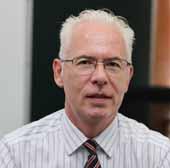
The Jindal School of Language and Literature (JSLL) provides an environment for holistic study of languages, literature and culture with organic connections to other JGU schools and centres. JSLL gives attention to not only multiple languages and their literatures but to comparative literature, world literature and cultural studies. Students in JSLL programmes will encounter not only languages and texts but other cultural forms such as performing arts and cinema. JSLL is devoted to the proposition that language and literature matter today more than ever for human fulfilment and a safe

collective future. JSLL currently offers two undergraduate programmes - BA Honours English and BA Honours Spanish. Prof. (Dr) Denys P. Leighton is the Dean of JSLL .

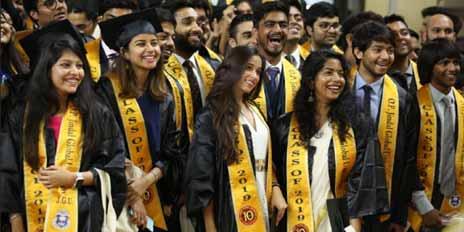
The Jindal School of Public Health and Human Development (JSPH) was founded in 2020, right amidst the pandemic, and aspires to be a worldclass public health institution, that meets the constantly-evolving and dynamic needs of public health in India, and across the world. JSPH with its research driven approach and interdisciplinary studies aims to create leaders who can bring thought leadership to create a constantly-evolving, adaptable and sustainable public health ecosystem for India and the world. Prof. (Dr) Stephen P. Marks is the Dean of JSPH, which currently offers as its flagship programme, the Masters in Public Health (MPH), which is a highly innovative and specialised programme of study that leverages JGU’s extensive engagement in the field of public health in India.
Established in 2014, the Jindal Institute of Behavioural Sciences (JIBS) stands as a cornerstone of value-driven research within JGU. This institute also proudly bears affiliation with the Academic Council on the United Nations System (ACUNS), as a testament to its international academic standing. Dedicated to the intricate realm of behavioural sciences, JIBS is committed to the pursuit of empirical research that interweaves various disciplines. With an unwavering emphasis on applied and
Professor (Dr.) Stephen P. Marks Dean, JSPH
experimental methodologies, JIBS’ primary spheres of exploration encompass a diverse array of subjects: mental health, competency mapping, neurosciences, neural decision sciences, psychobiology, management sciences, forensic studies, social psychology, and the complexities of criminal behaviour.
Collaborating with leading scholars across an array of fields and working in concert with both domestic and international researchers, the JIBS’ mission is to understand the complexity of human behaviour. Through this multifaceted lens, JIBS addresses the pressing issues with a keen awareness of their interdisciplinary nature.
Prof. (Dr.) Sanjeev P. Sahni is the Principal Director of JIBS. He is also the Advisor to the Vice-Chancellor of JGU and the Member of the Governing Body of the university. As a founding member of the management team, he was instrumental in establishing the university in the year 2009 along with the Vice Chancellor. Dr. Sahni fosters collaboration across the university and manages changes in policies and practices that affect the academic and administrative life of the university as a whole. He also serves as a Professor in the university and as the Director of the Centre for Victimology and Psychological Studies, Centre for Leadership and Change, and Centre for Community Mental Health.
Dr. Sahni is a distinguished scholar in the field of Psychology and his research interests span in the areas of Criminal Psychology, Cognitive and Neuropsychology, Competency Mapping,
Organizational Development, and Leadership. He holds a Ph.D. degree in Organizational Behaviour. He possesses an extensive and rich experience of 32 years in Academia, Industry and Governmental Sector. His industrial expertise and extensive research allow for a more pragmatic approach in teaching, thus narrowing the industryacademia gap.
From its very outset, JGU’s motto has been ‘A Private University Promoting Public Service’, and this reflects in the university’s ethos to foster academic excellence, intellectual engagement and social responsibility, across all its schools, institutes and research initiatives. But nowhere is it more seen than in its executive education initiative, the Jindal Institute of Leadership Development and Executive Education (JILDEE).
In today’s fast-paced and ever-changing business landscape, the need for effective leaders has become more crucial than ever. With a vision to promote leadership development and executive education within various sectors, JILDEE collaborates with its 12 schools and national and international academic partners to provide topnotch programmes tailored to mid and senior- level career officers.
These programmes cater to professionals in areas such as Financial Management, Law and Corporate Governance, Leadership and

Professional Development, Project and Process Management, Economics, Marketing and Sales, Technology, Innovation, Strategy, Government and Public Policy, Taxation, Diplomacy, and International Affairs.
One of the main strengths of the executive education at JGU is its globally focused faculty. The faculty members are highly qualified and trained, with expertise drawn from leading institutions such as Harvard, Yale, Columbia, Stanford, Oxford, Cambridge, and more. Their diverse backgrounds and experiences bring a global perspective to the programmes, enriching the learning experience for all participants.
Some of the domains where JGU offers unparalleled expertise for executive education include Strategic Management, Technology Based Programmes, Quantitative Research Methods, IS and Analytics, Digital Transformation, Data Visualization, Machine Learning, AI, Leadership, Organisational Behaviour and Human Resource Management and Supply Chain Management.
A recent instance of JILDEE’s success was the first Online Certificate Executive Education Programme with CAG for 25 officers of a Maharatna Public Sector Undertaking, the Power Grid Corporation of India Limited. This programme was a resounding success and received positive feedback from all participants.
In June 2023, JILDEE collaborated with Jindal School of Government and Public Policy (JSGP) to conduct an on-campus training programme for officers of the Indian Forest Service. The programme aimed to provide specialised training to officers in various areas such as forest conservation, wildlife management, and sustainable development. The programme was well-received by all participants and helped enhance their skills and knowledge in their respective fields.
JILDEE’s commitment to providing quality education and training to student officers across India is
Prof. (Dr.) Sanjeev P Sahni, Principal Director, JIBScommendable, as its efforts have helped bridge the gap between academia and industry, thereby creating a skilled workforce that is well-equipped to tackle the challenges of the future. The Chief Administrative Officer of JGU, Lt Gen Dr Rajesh Kochhar, also heads JILDEE as its Senior Director .
The Office of Executive education in Jindal Global Business School (JGBS), provides programmes that are designed to tackle real-world business problems and enable executives to generate the best return on investment. JGU collaborates with industry practitioners, experts, and organisations to resolve real world business issues, build diverse capabilities, and prepare for a dynamic future.
The outstanding DNA of a high-flying institution like JGU can definitely be traced back to its Founding Chancellor and Founding Vice Chancellor. JGU’s Founding Chancellor Mr. Naveen Jindal also serves as the Chairman of Jindal Steel and Power Limited, and has been an active campaigner for population stabilisation, women’s empowerment, environmental conservation, healthcare and education. After graduating in Commerce from Hans Raj College, Delhi University, in 1990, Mr. Jindal completed his MBA at the University of Texas at Dallas in 1992.
He was the President of the Student Government and recipient of the Student Leader of the Year Award at the University of Texas. Later on, as an

acknowledgement of Jindal’s donations to his alma mater, the University of Texas at Dallas renamed its School of Management to Naveen Jindal School of Management in 2011. Mr. Naveen Jindal is most famous in India as the leader who won the right to display the National Flag on all days of the year for all Indians, after a protracted legal battle with state and central governments, that he finally won at the Supreme Court.
Founding Vice Chancellor of JGU, Prof. (Dr) C. Raj Kumar, was awarded the prestigious Rhodes Scholarship at the University of Oxford, UK, where he obtained his Bachelor of Civil Law (BCL) degree; a Landon Gammon Fellowship at the Harvard Law School, USA, where he obtained his

Master of Laws (LLM) degree and a James Souverine Gallo Memorial Scholarship at Harvard University.
Later on, he received his Doctor of Legal Science (SJD) from the University of Hong Kong. He has also obtained a Bachelor of Laws (LLB) degree from the University of Delhi, India; and a Bachelor of Commerce (BCom) degree from the Loyola College, University of Madras, India. He served as a faculty member at the School of Law of City University of Hong Kong, where he taught for many years.
Professor Kumar has held consultancy assignments in the field of human rights and governance. He has been a Consultant to the United Nations University (UNU), Tokyo; United Nations Development Program (UNDP); UN Office of the High Commissioner of Human Rights, Geneva; and the International Council for Human Rights Policy (ICHRP), Geneva. He has advised the Commission to Investigate Allegations of Bribery or Corruption (CIABOC) in Sri Lanka and the National Human Rights Commission (NHRC) in India on issues relating to corruption and good governance. Professor Kumar is also an Attorney at Law and is admitted to the Bar Council of Delhi, India, and the Bar of the State of New York, USA.



Indian entrepreneurial spirit is constantly in search of second homes across the world. Western Australia, the largest state in Australia and home to its fourth most populous city, Perth, probably caught the attention of Indian entrepreneurial explorers and pioneers due to that feeling when just an ocean separates these two giant regions, even though the Chennai-Perth aerial distance is over 6000 kms. But in recent decades, the cultural and economic friendship and partnership between these two regions have grown beyond such geographic considerations. Organizations like the Australia India Business Council and the Invest & Trade WA Mission to India also provide valuable support and insights to Indian companies for successfully setting up shop in Western Australia. Here are 6 sectoral advantages that demonstrate why Western Australia is like no other opportunity for Indian businesses.
Itwill be an understatement to begin by saying that there are countless opportunities awaiting Indian businesses in Western Australia. Firstly, there is a mutual and perfect match between these two regions as on one side there is the vibrant and fast growing economy of India, and on the other side the resource-rich lands of Western Australia.
Secondly, the whole world is pivoting towards the Asia-Pacific region in search of growth, and this presents a geographical advantage for Indian businesses as they are among the best positioned to contribute to and benefit from the opportunities presented by this world’s second largest state, second only to Russia’s Sakha Republic, and at around 77% of the land area of India.
Thirdly, there is an often overlooked demographic synergy between India and Western Australia. Despite being similar sized in land areas, India’s population is nearly 500 times that of WA, which gives rise to unique high value trade opportunities for both regions. For instance, the number of dollar millionaires in India is around 800,000, which amounts to around 28% of the population of WA. This Australian state has been utilizing this Indian demographics to increase high value exports targeting Indian HNIs like premium seafood.
Last but not least, there is a strong cultural connection that goes beyond just economics, which has emerged into a socio-economic synergy between India and Western Australia. The vibrant Indian diaspora including immigrants, people of Indian origin, and students is one of the largest in Perth and other cities and is a testament to the strong ties that bind the two regions. This cultural connection eases the path for Indian businesses, providing a familiar environment for their ventures to thrive.
For Indian entrepreneurs, the time is ripe to explore the golden opportunities that WA offers,
by building bridges of commerce and friendship that span oceans and continents, especially by leveraging those sectors that are ripe for growth and the cultural ties that facilitate this international partnership. It will then be a narrative of mutual benefit and shared success, painting a picture of a future where the Indian entrepreneurial spirit finds a second home in the vastness of Western Australia.
Western Australia (WA), best known for its vast mineral resources, has traditionally been the bedrock of Australia’s export-driven economy. However, in recent years, the WA state government has been actively seeking to diversify its economic portfolio. This strategic shift has opened a plethora of opportunities for Indian businesses in sectors such as tourism, education, agriculture, and technology.
So, here are six established as well as emerging sectoral opportunities for Indian businesses in Western Australia, as well as examples of Indian businesses that are already pioneers in WA in these sectors.



India’s robust and thriving manufacturing sector, forever hungry for raw materials, can find a matching partner in WA’s mining industry. With the state’s abundant reserves of iron ore, lithium (more than half of world’s supply), and other critical minerals, Indian companies can secure a reliable supply chain that fuels their domestic growth while contributing to WA’s export earnings. Indian investments are now a key target of WA’s minerals reforms, with a focus on projects that support decarbonization and sustainable practices. As India commits to renewable energy on a massive scale, WA’s expertise in solar and wind power becomes increasingly valuable. Collaborations in green technology can help India meet its energy goals while promoting sustainable practices in WA, creating a win-win scenario for the environment and the economy. In the energy transition sector of Western Australia, some key Indian companies are already making significant strides. Examples include Reliance Industries which is exploring green hydrogen investments in Western Australia, which aligns with the state’s focus on renewable energy and sustainability, and The Green Billions Ltd which is investing in sustainable energy projects in Western Australia, including in green hydrogen.

The untapped potential of WA’s tourism sector is an attractive canvas for Indian hospitality firms. With its pristine beaches, unique wildlife, and the enigmatic Outback, WA is a destination waiting to be discovered by the Indian middle class, eager for new travel experiences. Already, the flow of Indian tourists to Western Australia has rebounded and is reaching almost to pre-Covid levels now. Several Indian companies have already established themselves in the

tourism, hospitality and food sectors in Western Australia, especially in Perth. For example, Ganesh Foods is one of Perth’s largest retailers and wholesalers, and offers a wide range of Indian groceries, fresh sweets, spices, clothes, cosmetics, herbal products etc, thus catering to the Indian diaspora, tourists and beyond. In the food sector, Twin Flame Bayswater is a restaurant in Perth, known for its authentic vegetarian Indian cuisine, offering a variety of dishes and a special unlimited thali.

 SEASONAL MAGAZINE
SEASONAL MAGAZINE
The geographic vastness of the two regions of India and Western Australia, as well as their perceived nearness on both sides of the Indian ocean as well as the real distance of over 6000 kms give rise to numerous challenges as well as opportunities in various industries including shipping, logistics and supply chains. This has become all the more important for global companies with operations in both India and Western Australia, as they embrace India as a China Plus One strategy in ensuring seamless global supply chains for their manufacturing and transportation needs. Indian companies can become a vital part of the supply chain for renewable energy projects in WA, providing components, services, or technology. Western Australia has also been pushing for more flights, and more direct flights between the two regions for furthering the logistics for WA based exporters that deal in time-sensitive goods like seafoods. One example of a well established Indian company operating in these sectors is Indian Ocean Shipping Agencies, operating in Western Australia since 1990, which specializes in providing logistical services for importers, exporters, ship owners, vessel operators, and charterers.



WA’s expansive farmlands and advanced agricultural technologies offer Indian agribusinesses a chance to invest in food security. Joint ventures in agri-tech can lead to innovations that benefit both countries’ food production capabilities, ensuring a stable food supply while tapping into the growing demand for quality produce in India. Wine production and honey production is another area of promise, as Western Australia is renowned for both its red and white wines as well its huge and high quality collection of honeys. WA based wine companies like Jacob’s Creek have been successfully exporting to India since the last several years. Beyond such well known brands, there are also relatively lesser known companies of Indian origin that have made a mark in the non-food agribusiness sector of Western Australia. For example, TFS Corporation Ltd is engaged in the management of Indian sandalwood plantations in the east Kimberley region of Western Australia.

The educational sector in WA presents another lucrative avenue. Indian students are the second-largest group of international students in Australia, and WA’s universities are keen to welcome more. This influx not only enriches the local academic environment but also opens doors for Indian educational institutions to establish campuses, fostering a vibrant exchange of knowledge and culture. Numerous Indian private universities and Australian universities have tied up with each other to facilitate the easy movement of students and twinning programs.

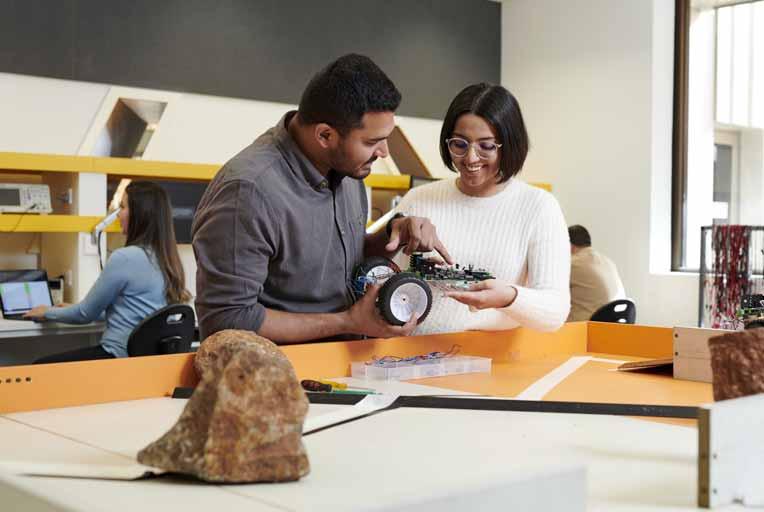

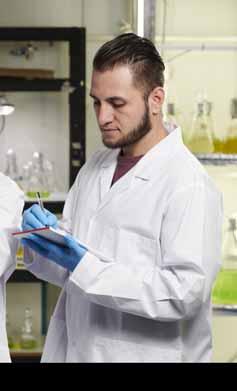
Western Australia’s push towards becoming a global hub for innovation aligns perfectly with India’s ongoing digital revolution. Indian tech firms can leverage WA’s innovationfriendly policies to set up research and development centers, tapping into the state’s skilled workforce and fostering technological advancements. Western Australia has various organizations, infrastructural facilities and programs, which Indian startups can leverage to set shop successfully in WA for access to a global audience. These include the India Australia Rapid Innovation and Startup Expansion (RISE) Accelerator program, Invest and Trade WA Mission to India, university level partnerships, WA government grants and funding to startups & SMEs, networking events, innovation hubs including WA Data Science and Innovation Hub and Innovation Central Perth, and extensive facilities like Spacecubed which requires a special mention of its own.

Companies and investors looking to set shop in Western Australia, will be most interested to know about the unique services of Spacecubed, one of the first startup accelerators and co-working space providers in the state. Over the eleven years of its existence, Spacecubed has helped 6638 business entities that include entrepreneurs, SMEs & corporates. The socioeconomic and environmental impact that Spacecubed has delivered to Western Australia has been estimated at $4 billion. Also, a startup investor in its own capacity, this accelerator had invested $1.5 million in WA based startups, which went on to generate $12 million in follow-on investments from other institutional investors. Spacecubed has five facilities now, which are Riff, Flux, Fern & CORE Innovation Hub, all at Perth, and Western Sydney Startup Hub at Paramatta, in Greater Western Sydney area of NSW. Spacecubed’s Perth Landing Pad is headed by its General Manager Chandra Sundareswaran, and his own experience as a founder and chief executive of startups is helping the Perth Landing Pad understand the needs of early and growth stage startups and SMEs in a better way. The Perth Landing Pad is also actively supported by the Department of Jobs, Tourism, Science & Innovation, of the Government of Western Australia. The Spacecubed facilities differentiate themselves as their various services are suitable for all kinds of companies ranging from startups to Fortune 500 firms.




While the opportunities are abundant, Indian businesses must navigate the challenges of setting up shop in a foreign land. Understanding local regulations, building networks, and adapting to cultural nuances are essential steps in this journey. Western Australia is fostering collaboration with Indian innovation ecosystems, as well as Indian entrepreneurs particularly in areas like digital economy, health and medical life sciences, space technology, energy transition, agriculture and agri-food etc. The Invest & Trade WA Mission to India can help Indian businesses discover opportunities for Joint Ventures and Partnerships, Investment in Local Projects, Research and Development Collaboration, Government and Industry Body Engagement, Technology Transfer, Skill Sharing and Training, and any other critical need an Indian business might face in Western Australia. With the promise of such all-round support, it is only natural that discerning Indian businesses are already making a beeline for Western Australia.

Seasonal Magazine in conversation with Nashid Chowdhury, Trade & Investment Commissioner, Govt of Western Australia
“India
Western Australia offers attractive, unique and exciting investment and trade opportunities, with a safe and secure environment in which to do business, along with world - leading innovation across a range of thriving industries. The Western Australia Government’s network of global investment and trade offices provide support and information for investors and buyers worldwide. In July 2022, the government announced the establishment of a new investment and trade office in Chennai to strengthen business and people-to-people ties. The Chennai office provides a vital trade link between the State and South India, supporting Western Australian businesses pursuing opportunities within the region. The set up and operations of the Chennai office is being overseen by Nashid Chowdhury, Investment and Trade Commissioner for the India-Gulf region. In this exclusive interview with Seasonal Magazine, Nashid talks about the key sectors where Western Australia has exhibited unique advantages & provided opportunities for commercialisation.
Seasonal Magazine (SM)
Seasonal Magazine (SM)
Seasonal Magazine (SM)
Seasonal Magazine (SM) : Western Australia is endowed with an abundance of critical minerals. The state has some of the most significant mineral deposits in the world and is a leading supplier of lithium, nickel, cobalt, manganese and rare earths. How does mining play a critical role in Western Australia’s economy?
Nashid Chowdhury (NC)
Nashid Chowdhury (NC)
Nashid Chowdhury (NC)
Nashid Chowdhury (NC) (NC) : Mining has been the backbone of our economy. Western Australia is known as the number one state when it

comes to mining & investment in mining. The reason is because we are home to 50 different critical minerals and rare earths, as well as 53% of the world’s lithium reserves. This creates a massive opportunity. Secondly, the state is geographically large, the largest state in Australia that is about 1/3 rd of the area. We also already export a lot of iron ore across the globe. We also have a huge abundance of LNG and that’s been a really big part of what has grown our economy as well. All of these critical
minerals are essential for developing future batteries used in EVs and other technologies. We have the opportunity to not only provide the raw materials for this purpose, but also to build the technology behind it. We are also home to the Future Battery Industries CRC, a federally funded initiative. And through that we are seeing a huge growth of different technologies that’s currently being found and being scaled as well.
SM SM SM SM SM: How has Western Australia
positioned itself as a leading tourism destination, especially for Indians?
NC NC: India has been one of Western Australia’s fastest recovering markets. In terms of visitor numbers, it is now back to 94% of pre-COVID levels. In 2023, for instance, WA welcomed 90,000 visitors from India, including those for international education. It continues to be a high priority market. The key focus is to tap into the visiting friends and relatives market and encourage travellers from India to

stay longer and explore more of the state. India is the third largest migrant community in WA and that’s growing quite exponentially. If we combine those who are Indian born/Indian ancestry, there’s about 160,000 to 170,000 people who are linked with the Indian diaspora community. Opening up a direct flight connection between Perth and an Indian city has been one of the key milestones for our government. It would not only unlock tourism opportunities but opportunities for our international education, trade and investment as well.
SM: SM: SM: Coming to the education sector, according to a report by StudyPerth Australia, Indians accounted for 18% of the international students who enrolled in a program at a Western Australian university between 2020 and 2021. How do you see the higher education opportunities taking off in the future?
NC: NC: NC: If you look at the flow effect, since international students are longer term visitors who are in the market, they have the potential to become future ambassadors for WA or who may choose to stay in WA. The Premier’s University Scholarship Program, which is valued at $50,000, was given out last year, and I think there were 3 successful applicants from India. Further, the University of Western Australia, for instance, has launched a Global MBA program in partnership with the Indian Institute of Management, Kozhikode, one of the prestigious business schools in the country. There are other collaborations between Western Australian & Indian universities, particularly in skilling and education in the field of mining and geology.

We have been able to partner with the Odisha government to get five funded scholars from the tribal communities to come out to WA and study. I think there’s a lot of merit in those relationships because it’s intergenerational change. It’s incredibly important to have those kinds of relationships and grow a global mining talent pipeline because in WA we have a number of skills demands. Since mining is our key industry, we are in need of geologists, surveyors, engineers etc.
SM: Western Australia has several state-funded Innovation Hubs that offer collaborative facilities, shared spaces and use of technologies to bring together innovators and entrepreneurs across the state and beyond. Could you share some examples and what is the larger purpose of these hubs?
NC: The purpose of these hubs is to almost act like a connector which are anchored or aligned to a particular university. But they’re also then working very closely with industry to understand what are the needs of that industry, the entire innovation cycle and challenges, opportunities, career growth options among others. A good example of this is the CyberWest, the cybersecurity Innovation Hub, that aims to improve WA’s cybersecurity posture, create employment in the cybersecurity sector, and diversify the economy. I was heavily involved in the CyberWest security hub, which started out with around 5 to 6 careers. By the time I moved on to setting up other innovation hubs, there were about 40 different careers in cybersecurity.
Other initiatives, like the Perth Landing Pad, are designed to cater to
international startups at different points in their business journey. Government of Western Australia has also supported the funding of the Perth landing pad, which is an initiative for entrepreneurs, especially connecting into Indian startup ecosystem, to be able to scale ups, particularly who are looking at a new market. So we are able to connect them into the Perth landing pad and this becomes an opportunity for them to connect into WA ecosystem.
Companies from across the globe, are invited to apply for the program, including established companies, SMEs, and scaleups. Those who will get the most out of this program are high growth companies looking to expand into APAC, ease of doing business and SMEs wanting to sell in the Australian market and connecting them to talent opportunities.
SM: SM: Western Australia has been endowed with some natural advantages in terms of geography & environmental conditions that are conducive for space tracking, communications & launch activities. What are the initiatives being mooted by the WA government to harness these natural advantages in the space sector?
NC: NC: NC: That’s right. We have great capabilities in remote operations. We are also one of the key radio silent zones in in the world. Space companies or startup doing launches benefit from the economic zones that are part of the south of WA. Australia has played a pioneering role in supporting space launch activities for India through its Australian Space Agency. India’s recent Chandrayaan3 lunar mission was a roaring success. A little known part, played
by WA, was in tracking the lander on its descent.
We also have a platform called WA investments, which has funded a green spaceport which is identified as a project where they’re looking at partners and investors looking to establish a space super corridor.
SM: SM: SM: One of the highlights of the interim free trade agreement – ECTA – was the removal of the 30% import tariff on live Australian lobster into India and other produce. What are some of the opportunities for WA businesses in this space?
NC: NC: NC: NC: NC: Although the India market for WA’s seafood produce is relatively small, the proportion of individuals with a high net worth is quite high in India, especially in comparison with the West Australian population. With live lobsters, there is a tariff reduction. So far we’ve had about somewhere between 500 to 600 kilos come into market, but they are mainly frozen. So again, this is the reason why we probably need more direct flights to be able to help us in that time span to get live lobsters and, on the other side, have the supply chain to be able to support it. There is a big opportunity for us to leverage on but there are already lobsters coming to market and they have a successful distributorship.
When it comes to wine, India imports more wine from Australia than any other country. The biggest player is well-known Barossa Valley company Jacobs Creek, which made the move into the Indian market 21 years ago. Wine currently accounts for just 1% of alcohol sales in India, with spirits and beer dominating the market. With its huge population and preference for red wine, we are hoping that major
Australian producers can help fill that gap. Being able to work with the state governments in India that we have a relationship with and grow that exponentially would be something that we’d like to see over the coming years.
Finally, we have had about 16,000 avocados coming to market via the first sea freight. We’ve also had an air freight come in. It’s been incredibly popular. Western Australia makes up I think 40% of Australia’s market share for avocados, so it’s a great opportunity for us to benefit through the interim free trade agreement.
SM: SM: SM: Lastly, could you talk about the recent health mission from Western Australia to India and what were some of the initiatives planned?
NC: NC: NC: As part of the health mission, Health Minister Amber-Jade Sandersonis was here on a 10-day mission to recruit Indian healthcare staff. The visit to Chennai, Hyderabad, Nashik and Trivandrum to meet healthcare representatives will help to bolster the capacity of additional 5000 healthcare workers in WA over the next decade. The aim is to build up these connections between our hospital service providers, education provider, service providers, key government agencies, major hospital groups on better connectivity & mobility programs. We are constantly looking at identifying the areas where we can have more exchange but also where there are areas of skill demands in the health skilling space for talent growth and pipeline with the full free trade agreement.
SEASONAL MAGAZINE
HOW CAN YOU CHANGE YOUR LIFE FOR THE BETTER TODAY? LEARN NOT JUST TO APPRECIATE HAPPINESS –BUT TO ANTICIPATE IT.
Have you heard about vorfreude? I recently came across this lovely word, which my German-speaking friend translated as “the anticipation of joy”. It struck me as such a hopeful concept – surely we could all do more vorfreude. So what exactly is anticipatory joy, how do we cultivate it and will it make us happier?
“The idea is to find joy in the lead-up to an event,” says Dr Sophie Mort, a clinical psychologist and mental health expert at the meditation and mindfulness app Headspace. “For example, we often feel joy and excitement when planning a trip, thinking about going on a date or anticipating a special meal.” It’s easy

to look forward to holidays and special occasions, but a joy-filled life is also about everyday occurrences.
Rory Platt, a writer at the personal development company The School of Life, says: “The trick lies in filling our calendar with lots of little moments to look forward to – like tiny baubles that, when seen from a distance, combine to make a more glittering future.”
But vorfreude is not about wishing your life away and thinking you will be happy in an imagined future. “Looking forward to something can trigger joy in the present moment,” says Karen Neil, a health coach and the founder of Mindful Medicine. This can boost your mood, reduce your stress levels and help to avoid

burnout. A 2017 study published in Frontiers of Psychology found that anticipating positive events activated the brain’s medial prefrontal cortex, which is associated with a higher level of wellbeing.
Doesn’t getting your hopes up risk disappointment? Perhaps it’s safer to keep expectations low. Emma Mills, a mindfulness expert and the author of Inhale Exhale Repeat, begs to differ. “There is a saying: ‘If you worry, you suffer twice.’ Anticipatory joy is the opposite of that.” Even if an anticipated event turns out to be a letdown, vorfreude helps people bounce back. “Optimists have improved coping abilities when dealing with unplanned distress and they tend to recover far faster,” says Tania Taylor, a psychotherapist and vorfreude advocate.
If you are going through a tough time and feel as though you have nothing to look forward to, don’t beat yourself up. “It’s important that positive psychology doesn’t get confused with toxic positivity,” says Taylor. “When I was going through cancer treatment, I spent most days binge watching television. It’s OK to sit tight when everything feels overwhelming without feeling guilt that you are not looking for joy.” If feelings of hopelessness persist, she stresses, it’s important to seek help from a GP, a therapist or charities.
If, however, you are ready for vorfreude, it shouldn’t feel like a chore. “Mostly, it will involve exploring what you already have in your life that you look forward to,” says Taylor. Willem Kuyken, a professor of mindfulness at the University of Oxford, has researched the benefits of cultivating joy. In his book Mindfulness for Life, he writes: “It takes only a small step out of habit and into awareness to enjoy the people we love around us, to savour food or to dance to music in our kitchen while cooking. These moments are available to us all the time.”
With that in mind, here are 30 simple ways to get more vorfreude in your life.
If the concept of vorfreude is completely alien to you, take baby steps. “Try to notice one joyful thing each day,” says Neil. You could frame this as a photo challenge: spend a little time every day looking for one beautiful flower, interesting sight or cute dog to photograph.
“Plan a morning affirmation or positive statement and look forward to starting your day with it in your mind,” says Taylor. “Some people create a screensaver with it on their phone so it’s the first thing they see.”
An example she gives is: “Today I will look for good moments and remember them.” Mort suggests: “May I be open to joy and have many moments of joy ahead.”
“A very small thing that I get vorfreude from is anticipating my first coffee of the day,” says Mort. “When I wake up, it’s the first thing I think about: how it will smell, how it will taste and how I will feel while drinking it. It’s a ritual that I love and I really allow myself to focus on it.”
“At the end of my evening meditation classes, I suggest people consider three things they are looking forward to tomorrow,” says Mills. “It could be their morning walk in the park or listening to a podcast on their commute; maybe sitting down to enjoy their packed lunch at work or looking forward to having a bath at the end of the day.”
“Perhaps you have a hobby such as gardening, or a pet to spend time with,” says Karen Atkinson, the CEO of MindfulnessUK. “Coming out of SEASONAL MAGAZINE
autopilot and consciously looking forward to these moments is an achievable way for anyone to experience vorfreude.”
“To change your mindset to become more joyful, you must first become familiar with your own negative thought patterns,” says Atkinson. These “mind traps” include catastrophising and discounting the positive. “For example, instead of thinking: ‘I’m only going away for one night – it’s hardly a holiday,’ say to yourself: ‘What a treat – a night away, going out to dinner and meeting friends. How lovely.’” The “shoulds” are another trap. “You may think: ‘I should have a more thriving social life, like everyone else.’ Instead, recognise that Fomo [fear of missing out] can add stress. Remember how fortunate you are to go out and have fun once in a while – really cherish the opportunity.”
“There is a small moment just before you eat your pastry, or the movie begins, or as you get in your bubble bath,” says Mills. “In that moment, the pastry hasn’t been eaten yet – it’s a joy about to be enjoyed. Savour the moment and think how lucky you are.” She likes a Kurt Vonnegut quote: “And I urge you to please notice when you are happy, and exclaim or murmur or think at some point: ‘If this isn’t nice, I don’t know what is.’”
“Schedule brief excursions and small indulgences,” says Platt. “Perhaps aim to finish work an hour early on Fridays to get dinner with a friend, visit an art gallery or take yourself on a solo cinema trip.” Don’t feel guilty about it. The team at The Mindfulness Project says: “Giving yourself permission to look forward to these pleasures can prepare you to enjoy them.”

One of the exercises in I Am Here Now, a book by The Mindfulness Project, is getting into the habit of writing down plans. The authors suggest rating your anticipation levels, but even the simple act of putting pen to paper can make plans feel more real and increase excitement.
“Joy is individual,” says Neil. “There are common themes – we can all appreciate a happy child playing –but it’s about finding what brings you joy.” She advises people to keep a joy journal, noting down what has made you happy that day, week or month. That way, you can plan more of it in the future.
“I’ll plan 10 minutes of gentle stretching or book an activity session such as a yoga, pilates or a sound bath class,” says Taylor. If that sounds more like punishment than pleasure, remember exercise is individual, too – so find something you enjoy.
“Creating a meal plan for the week means you can look forward to what you are going to eat,” says Taylor. She suggests using a slow cooker if you are pushed for time: “This week, I’m looking forward to making rice pudding in mine.”
Kareen Griffiths, a mindful change consultant, likes to plan a big night out. “I relish the moments in the buildup: putting on my outfit, the train journey, the feeling of excitement,” she says. Taylor gets just as much vorfreude out of arranging for a friend to come over to watch a film. The important thing is making time to meet up with someone you care about.
“The other day, I saw a social media post about a cheap mini-break to Rome. It had me getting excited about a variety of really affordable getaways – even though my passport has expired,” says Taylor. “I must get around to renewing it, but it doesn’t stop me from getting enjoyment out of the anticipation of what might be.”
“Some research shows that planning and anticipating a holiday can make you happier than the holiday itself,” says Mort. “This switched me from being a spontaneous ‘Oh, I’ll leave it till the last minute and book just before I go away’ person to being someone who takes time to mull over where I want to go, why I want to go there and how it might be when I get there.”
(Credit: Rachel Dixon for The Guardian)

ob Sutton is a professor of management science at the Stanford University School of Engineering. Huggy Rao is the Atholl McBean professor of organizational behavior and human resources at the Stanford Graduate School of Business.
Leaders and teams that are especially good at making the right things easy and the wrong things hard embrace a similar mindset or mission. They have an attitude that we call the trustees’ mindset. They see themselves as trustees of others’ time. When we were at Stanford preparing a class for 60 executives, our colleague Jeremy Utley stood up in the middle of the meeting and bellowed, “I hate wasting other people’s time!” That is the embodiment of the trustees’ mindset—a leader who feels obligated to assure that their employees, customers, or students have every minute of their time used well. Being a trustee is never a one-and-done situation. Back in 2015, I wrote an article about how Dropbox had this amazing intervention called Armeetingeddon in 2013, where leaders removed standing meetings from everybody’s calendar, and employees couldn’t add new meetings back in for about a week. During this time, they were asked to think about which meetings were essential. Dropbox also made all these new rules and displayed them on the walls, like, for example, that you
should keep meetings as small as possible, and you should even leave a meeting if it wasn’t effective or you weren’t adding value. They did reduce the number of unnecessary meetings for a while, but when we wrote it up for Inc. two years later, their CEO, Drew Houston, told us, “It’s worse than ever. It’s like mowing the lawn; you’ve got to do it over and over again with discipline where you never fix anything.” Adopting the trustees’ mindset is like mowing the lawn. It’s a way of life, a discipline.
When we see people and organizations that are skilled at fighting bad friction, they adopt what
we call the subtraction mindset. This is not something that comes naturally to human beings. A series of 20 studies done by researchers from the University of Virginia shows that humans are wired to solve problems by adding rather than subtracting complexity. Adding complexity is our natural tendency, whether we’re planning a vacation, fixing a Lego model, or fixing a university. The organizations we studied made this problem worse by rewarding people who build fiefdoms, start initiatives, and add software—and not rewarding people who reduce complexity.
That’s the bad news. The good news is that there are many things in the organizations we studied that people do using the subtraction mindset.
A great example happened at Hawaii Pacific Medical, Hawaii’s largest healthcare system. A woman named Dr. Melinda Ashton was concerned about the excessive time that doctors, nurses, and so forth were spending on the electronic patient record system instead of focusing on patients directly. So she started the Get Rid of Stupid Stuff campaign. She had people make suggestions from throughout the system about parts of the electronic record process that


could be subtracted or simplified. She described it as “parts that were poorly designed, unnecessary, or just plain stupid.”
People in the system suggested 188 subtraction targets, and her team made 87 improvements. Here is one, just to give you an example: They eliminated one mouse click that was made for every patient as nurses and nurse assistants made rounds. With just that one little click removed, they saved 24 seconds per click, which saved approximately 1,700 nursing hours per month at their four hospitals. Embrace the subtraction mindset.
Our third lesson is to watch your language; avoid using what Huggy and I call jargon monoxide. All sorts of destructive friction is caused when people routinely use overly complex or incomprehensible language.
Just one example is jargon mishmash syndrome. This is when a certain kind of language or phrase means so many things to so many different people that it is meaningless. We’re taking a cue from Nobel Prize winner Daniel Kahneman. He talks about noise being a big problem when it comes to figuring out the correct action because recommendations, data, or definitions that people use are so varied and inconsistent that people can’t figure out what to do, whom to trust, or what some idea “really means.” Kahneman defines noise as situations where there is “a random scatter of ideas” rather than a discernable pattern.
An example that illustrates noise is a speech given by an Australian agile consultant. This fellow Craig Smith gave a rollicking 40-minute speech describing 40 different kinds of agile—everything from holacracy, scrum plop, deming, beyond budgeting, and lean startup. Many were methods that, frankly, I’ve never heard of. If under the tent of agile

there are 40 different meanings of the word agile, then agile means at least 40 different things to different people. This fits Kahneman’s definition of a “random scatter of ideas,” and thus, it means nothing.
When you get in a situation where you’ve got the jargon mishmash syndrome, the best solution is just to stop using the worn-out term in question. Clean up your language, and people will be less confused, communicate better, and know what the heck to do!
There are situations where friction is good. Friction fixers banish bad friction and identify things that ought to be difficult, slow, or impossible. To give you one example, let’s look at research on creativity. Teresa Amabile, a professor from Harvard Business School, explains that when you put creativity under the gun and rush people too much, all sorts of bad things happen. Creativity is a fundamentally inefficient process. It entails a lot of dead ends, failure, and constructive conflict—when you’re doing it right.
The lesson here is Jerry Seinfeld. The famous comedian and cocreator of the TV show Seinfeld says, “When it comes to comedy, the hard way is the right way; there is no natural way to make it efficient.” When he prepares a show, he will try hundreds and hundreds of jokes, and maybe 1% or 2% will survive. When it comes to many things in life, they should be
slow, difficult, and complicated. Trying to build a frictionless organization is a fool’s errand.
The best leaders are of two minds. Their first perspective is focused on being good organizational designers: removing bad procedures, weaving together knowledge and action from different corners of the company, making unethical or dumb things impossible, and a host of other changes in how the organization operates. So they’re constantly thinking about ways to clean up the mess by improving organization design.
But they also are of another mind that knows that there will be procedures, laws, and rules that are dumb, dangerous, and impair progress, which leaders and teams can’t escape or repair—at least for now. As in the rest of life, there will always be difficult stretches, times when people in workplaces are confused, upset, and can’t figure out how to fix things. Being a friction fixer means figuring out how to cope with and navigate messy situations. Here’s what great leaders do in such situations. Clara Shih is CEO of AI at Salesforce, a member of Starbucks’s board since she was 29, and the chair and founding CEO of her own company, Hearsay Systems. Shih says that when she launches something new, she urges her team to embrace the mess. She uses an approach called separation of concerns, which is from computer science. She has one team that focuses on implementing things that are working well, and she has another team whose job is to clean up the inevitable messes that arise.
As a friction fixer and trustee of others’ time, you often have to do two things at once: keep people charging ahead on the things going right and as planned, and handle the inevitable surprises, setbacks, confusion, and other messes that need cleaning up. (Credit: Next Big Idea Club)
SEASONAL MAGAZINE
Will Douglas Heaven is the senior editor for AI at MIT Technology Review, and himself a PhD in computer science from Imperial College London who has earlier worked with robots. Earlier he was the founding editor at the BBC tech-meets-geopolitics website Future Now and chief technology editor at New Scientist magazine. In this article for MIT Technology Review, this ace AI writer sounds the alarm about where AI is heading. For instance, large language models like ChatGPT can do jaw-dropping things. But nobody knows exactly why. And that’s a problem. Figuring it out is one of the biggest scientific puzzles of our time and a crucial step towards controlling more powerful future models.
Two years ago, Yuri Burda and Harri Edwards, researchers at the San Francisco–based firm OpenAI, were trying to find out what it would take to get a language model to do basic arithmetic. They wanted to know how many examples of adding up two numbers the model needed to see before it was able to add up any two numbers they gave it. At first, things didn’t go too well. The models memorized the sums they saw but failed to solve new ones.
By accident, Burda and Edwards left some of their experiments running far longer than they meant to—days rather than hours. The models were shown the example sums over and over again, way past the point when the researchers would otherwise have called it quits. But when the pair at last came back, they were surprised to find that the experiments had worked. They’d trained a language model to add two numbers— it had just taken a lot more time than anybody thought it should.
Curious about what was going on, Burda and Edwards teamed up with colleagues to study the phenomenon. They found that in certain cases, models could seemingly fail to learn a task and
then all of a sudden just get it, as if a lightbulb had switched on. This wasn’t how deep learning was supposed to work. They called the behavior grokking.
“It’s really interesting,” says Hattie Zhou, an AI researcher at the University of Montreal and Apple Machine Learning Research, who wasn’t involved in the work. “Can we ever be confident that models have stopped learning? Because maybe we just haven’t trained for long enough.”
The weird behavior has captured the imagination of the wider research community. “Lots of people have opinions,” says Lauro Langosco at the University of Cambridge, UK. “But I don’t think there’s a consensus about what exactly is going on.”
With hopes and fears about the technology running wild, it’s time to agree on what it can and can’t do.
Grokking is just one of several odd phenomena that have AI researchers scratching their heads. The largest models, and large language models in particular, seem to behave in ways
textbook math says they shouldn’t. This highlights a remarkable fact about deep learning, the fundamental technology behind today’s AI boom: for all its runaway success, nobody knows exactly how—or why—it works.
“Obviously, we’re not completely ignorant,” says Mikhail Belkin, a computer scientist at the University of California, San Diego. “But our theoretical analysis is so far off what these models can do. Like, why can they learn language? I think this is very mysterious.”

The biggest models are now so complex that researchers are studying them as if they were strange natural phenomena, carrying out experiments and trying to explain the results. Many of those observations fly in the face of classical statistics, which had provided our best set of explanations for how predictive models behave.
So what, you might say. In the last few weeks, Google DeepMind has rolled out its generative models across most of its consumer apps. OpenAI wowed people with Sora, its stunning new text-to-video model. And businesses around the world are scrambling to co-opt AI for their needs. The tech works—isn’t that enough?
But figuring out why deep learning works so well isn’t just an intriguing scientific puzzle. It could also be key to unlocking the next generation of the technology—as well as getting a handle on its formidable risks.
“These are exciting times,” says Boaz Barak, a computer scientist at Harvard University who is on secondment to
OpenAI’s superalignment team for a year. “Many people in the field often compare it to physics at the beginning of the 20th century. We have a lot of experimental results that we don’t completely understand, and often when you do an experiment it surprises you.”
Most of the surprises concern the way models can learn to do things that they have not been shown how to do. Known as generalization, this is one of the most fundamental ideas in machine learning—and its greatest puzzle. Models learn to do a task—spot faces, translate sentences, avoid pedestrians— by training with a specific set of examples. Yet they can generalize, learning to do that task with examples they have not seen before. Somehow, models do not just memorize patterns they have seen but come up with rules that let them apply those patterns to new cases. And sometimes, as with grokking, generalization happens when we don’t expect it to.
Large language models in particular, such as OpenAI’s GPT-4 and Google DeepMind’s Gemini, have an

astonishing ability to generalize. “The magic is not that the model can learn math problems in English and then generalize to new math problems in English,” says Barak, “but that the model can learn math problems in English, then see some French literature, and from that generalize to solving math problems in French. That’s something beyond what statistics can tell you about.”
When Zhou started studying AI a few years ago, she was struck by the way her teachers focused on the how but not the why. “It was like, here is how you train these models and then here’s the result,” she says. “But it wasn’t clear why this process leads to models that are capable of doing these amazing things.” She wanted to know more, but she was told there weren’t good answers: “My assumption was that scientists know what they’re doing. Like, they’d get the theories and then they’d build the models. That wasn’t the case at all.”
The rapid advances in deep learning over the last 10-plus years came more from trial and error than from understanding. Researchers copied what worked for others and tacked on innovations of their own. There are now many different ingredients that can be added to models and a growing cookbook filled with recipes for using them. “People try this thing, that thing, all these tricks,” says Belkin. “Some are important. Some are probably not.”
“It works, which is amazing. Our minds are blown by how powerful these things are,” he says. And yet for all their success, the recipes are more alchemy than chemistry: “We figured out certain incantations at midnight after mixing up some ingredients,” he says.
The problem is that AI in the era of large language models appears to defy textbook statistics. The most powerful models today are vast, with up to a trillion parameters (the values in a model that get adjusted during training). But statistics says that as models get bigger, they should first improve in performance but then get worse. This is because of something called overfitting.
When a model gets trained on a data set, it tries to fit that data to a pattern. Picture a bunch of data points plotted
on a chart. A pattern that fits the data can be represented on that chart as a line running through the points. The process of training a model can be thought of as getting it to find a line that fits the training data (the dots already on the chart) but also fits new data (new dots).
A straight line is one pattern, but it probably won’t be too accurate, missing some of the dots. A wiggly line that connects every dot will get full marks on the training data, but won’t generalize. When that happens, a model is said to overfit its data.
According to classical statistics, the bigger a model gets, the more prone it is to overfitting. That’s because with more parameters to play with, it’s easier for a model to hit on wiggly lines that connect every dot. This suggests there’s a sweet spot between under- and overfitting that a model must find if it is to generalize. And yet that’s not what we see with big models. The best-known example of this is a phenomenon known as double descent.
The performance of a model is often represented in terms of the number of errors it makes: as performance goes up, error rate goes down (or descends). For decades, it was believed that error rate went down and then up as models got bigger: picture a U-shaped curve with the sweet spot for generalization at the lowest point. But in 2018, Belkin and his colleagues found that when certain models got bigger, their error rate went down, then up—and then down again (a double descent, or W-shaped curve). In other words, large models would somehow overrun that sweet spot and push through the overfitting problem, getting even better as they got bigger.
A year later, Barak coauthored a paper showing that the double-descent phenomenon was more common than many thought. It happens not just when models get bigger but also in models with large amounts of training data or models that are trained for longer. This behavior, dubbed benign overfitting, is still not fully understood. It raises basic questions about how models should be trained to get the most out of them.
Researchers have sketched out versions of what they think is going on. Belkin
believes there’s a kind of Occam’s razor effect in play: the simplest pattern that fits the data—the smoothest curve between the dots—is often the one that generalizes best. The reason bigger models keep improving longer than it seems they should could be that bigger models are more likely to hit upon that just-so curve than smaller ones: more parameters means more possible curves to try out after ditching the wiggliest.
“Our theory seemed to explain the basics of why it worked,” says Belkin. “And then people made models that could speak 100 languages and it was like, okay, we understand nothing at all.” He laughs: “It turned out we weren’t even scratching the surface.”
For Belkin, large language models are a whole new mystery. These models are based on transformers, a type of neural network that is good at processing sequences of data, like words in sentences.
There’s a lot of complexity inside transformers, says Belkin. But he thinks at heart they do more or less the same thing as a much better understood statistical construct called a Markov chain, which predicts the next item in a sequence based on what’s come before. But that isn’t enough to explain everything that large language models can do. “This is something that, until recently, we thought should not work,” says Belkin. “That means that something was fundamentally missing. It identifies a gap in our understanding of the world.”
Belkin goes further. He thinks there could be a hidden mathematical pattern in language that large language models somehow come to exploit: “Pure speculation but why not?”
“The fact that these things model language is probably one of the biggest discoveries in history,” he says. “That you can learn language by just predicting the next word with a Markov chain—that’s just shocking to me.”
Researchers are trying to figure it out piece by piece. Because large models are too complex to study themselves, Belkin, Barak, Zhou, and others experiment instead on smaller (and older) varieties of statistical model that

are better understood. Training these proxies under different conditions and on various kinds of data and observing what happens can give insight into what’s going on. This helps get new theories off the ground, but it is not always clear if those theories will hold for larger models too. After all, it is in the complexity of large models that many of the weird behaviors reside. Is a theory of deep learning coming? Daniel Hsu, a computer scientist at Columbia University who was one of Belkin’s coauthors on the doubledescent paper, doesn’t expect all the answers anytime soon. “We have better intuition now,” he says. “But really explaining everything about why neural networks have this kind of unexpected behavior? We’re still far from doing that.”
In 2016, Chiyuan Zhang at MIT and colleagues at Google Brain published an influential paper titled “Understanding Deep Learning Requires Rethinking Generalization.” In 2021, five years later, they republished the paper, calling it “Understanding Deep Learning (Still)

Requires Rethinking Generalization.” What about in 2024? “Kind of yes and no,” says Zhang. “There has been a lot of progress lately, though probably many more questions arise than get resolved.”
Meanwhile, researchers continue to wrestle even with the basic observations. In December, Langosco and his colleagues presented a paper at NeurIPS, a top AI conference, in which they claimed that grokking and double descent are in fact aspects of the same phenomenon. “You eyeball them and they look kind of similar,” says Langosco. He believes that an explanation of what’s going on should account for both.
At the same conference, Alicia Curth, who studies statistics at the University of Cambridge, and her colleagues argued that double descent is in fact an illusion. “It didn’t sit very well with me that modern machine learning is some kind of magic that defies all the laws that we’ve established so far,” says Curth. Her team argued that the double-descent phenomenon—where models appear to
perform better, then worse, and then better again as they get bigger—arises because of the way the complexity of the models was measured.
Belkin and his colleagues used model size—the number of parameters—as a measure of complexity. But Curth and her colleagues found that the number of parameters might not be a good stand-in for complexity because adding parameters sometimes makes a model more complex and sometimes makes it less so. It depends what the values are, how they get used during training, and how they interact with others—much of which stays hidden inside the model. “Our takeaway was that not all model parameters are created equal,” says Curth. In short, if you use a different measure for complexity, large models might conform to classical statistics just fine. That’s not to say there isn’t a lot we don’t understand about what happens when models get bigger, says Curth. But we already have all the math we need to explain it.
A great mystery of our time
It’s true that such debates can get into the weeds. Why does it matter whether AI models are underpinned by classical statistics or not?
One answer is that better theoretical understanding would help build even better AI or make it more efficient. At the moment, progress has been fast but unpredictable. Many things that OpenAI’s GPT-4 can do came as a surprise even to the people who made it. Researchers are still arguing over what it can and cannot achieve. “Without some sort of fundamental theory, it’s very hard to have any idea what we can expect from these things,” says Belkin.
Barak agrees. “Even once we have the models, it is not straightforward even in hindsight to say exactly why certain capabilities emerged when they did,” he says.
This isn’t only about managing progress—it’s about anticipating risk, too. Many of the researchers working on the theory behind deep learning are motivated by safety concerns for future models. “We don’t know what capabilities GPT-5 will have until we train it and test it,” says Langosco. “It might be a medium-size problem right now, but it will become a really big problem in the future as models become more powerful.”
Barak works on OpenAI’s superalignment team, which was set up by the firm’s chief scientist, Ilya Sutskever, to figure out how to stop a hypothetical superintelligence from going rogue. “I’m very interested in getting guarantees,” he says. “If you can do amazing things but you can’t really control it, then it’s not so amazing. What good is a car that can drive 300 miles per hour if it has a shaky steering wheel?”
But beneath all that there’s also a grand scientific challenge. “Intelligence is definitely up there as one of the great mysteries of our time,” says Barak.
“We’re a very infant science,” he says. “The questions that I’m most excited about this month might be different to the questions that I’m most excited about next month. We are still discovering things. We very much need to experiment and get surprised.”
SEASONAL MAGAZINE
WHILE PLENTY OF HEALTH CONDITIONS MAKE YOU PAINFULLY AWARE OF THEIR PRESENCE VIA ANY NUMBER OF IMPOSSIBLE-TO-IGNORE SYMPTOMS, HIGH BLOOD PRESSURE (A.K.A. HYPERTENSION) CAN BE A SNEAKIER BEAST. YOU CAN LITERALLY WALK AROUND ALL DAY, EVERY DAY WITHOUT A CLUE THAT YOUR BLOOD PRESSURE NUMBERS ARE HIGHER THAN THEY SHOULD BE — MANY PEOPLE DON’T HAVE PHYSICAL SYMPTOMS THAT THEY CAN FEEL. ALTHOUGH PEOPLE WHO HAVE HIGH BLOOD PRESSURE (WHICH IS NEARLY HALF OF ADULTS IN THE US) MIGHT NOT HAVE ANY DISCOMFORT FROM IT MOST OF THE TIME, IT’S REALLY SERIOUS. HIGH BLOOD PRESSURE SIGNIFICANTLY UPS YOUR RISK OF HEART ATTACK AND STROKE, MAKES YOU MORE LIKELY TO DEVELOP KIDNEY DISEASE, AND CAN EVEN MESS WITH YOUR SEX DRIVE. BUT THESE TWEAKS TO YOUR DAILY ROUTINE CAN MAKE A HUGE DENT IN YOUR BP NUMBERS.
Rampant as high blood pressure is, getting it under control can be a tricky business. Kathryn Harris, MD, cardiologist tells that more than half of people treated for high BP don’t have it under control, meaning that it stays high despite treatment like medication. While the ideal reading is less than 120/80 mmHg (the top number is your systolic pressure and the bottom number is your diastolic pressure), BP that lingers above 140/ 90 mmHg typically requires both medication and lifestyle changes to rein it in, according to the American Heart Association (AHA).
If you’re one of the many people struggling to keep the beast of high blood pressure on a leash, let us make one thing crystal clear: Significantly lowering blood pressure is tough— and often requires taking medication (in many cases, more than one) and making some pretty serious changes to your lifestyle. It’s complicated stuff, and can take some trial and error. Finding the right balance of medications and switching up your behaviors around food, exercise, and
other key parts of the way you live your life can feel challenging for even those who can afford any prescriptions they need, shop at the health food store, and try out the latest fitness studio in town. And yet, many of the people with the greatest risk of high BP and its downstream effects live with limited access to hearthealthy food or medication that’s within their budgets, says Estelle Darlyse Jean, MD, a board-certified non-invasive cardiologist with MedStar Heart & Vascular Institute.

There’s a LOT of work to be done to ensure that the variety of resources that help with heart health are available to all people. But there are still realistic, gradual ways you can bring those blood pressure numbers down, even when the cards are stacked against you.
One method is through the power of your lifestyle, which, yes, is really freakin’ powerful—even if you’re not taking blood pressure meds, you can often make a big dent in your numbers (and if you are, you can use these tactics to support the meds as they do their thing). Tweaks to your habits can lower blood pressure by at least as much as a single medication, says Dr. Jean. Regardless of your medication situation, moving towards a more blood-pressure-

friendly daily routine makes a big impact—and you don’t have to overhaul your entire life to see encouraging results at your next check-up. Here’s where to start.
Dr. Jean and Dr. Harris both say that exercise is one of the biggest needlemovers for your blood pressure out there. Moving your body can potentially knock your numbers down by about five mmHg. Your goal: 30plus minutes of moderate-intensity movement like power walking at least three days a week.
If that feels like a lot, don’t panic; research shows that as little as 30 to 60 minutes of exercise per week has a notable impact on blood pressure. Start where you are and increase as you’re able. You don’t have to log 30 straight minutes of movement at a time either. Little exercise “snacks” add up, so try out tactics like dance parties while making dinner, taking the dog for a spin around the block in the morning, or even pacing around the room while you’re on the phone, per suggestions from Colorado State University.
You can also practice a wall sit while catching up on your favorite show; a recent study found that, while pretty much all forms of movement do good by your BP, isometric exercise (in which you build strength by holding a position, not moving—think planks and chair poses), takes the cake.
Sodium is a notorious foe for anyone trying to get their blood pressure down, so minding the salt in your diet is a must-do. Though most Americans consume upwards of 3,400 milligrams of sodium per day (mostly from packaged and restaurant foods),
the AHA recommends sticking below 2,300 milligrams—and ideally below 1,500 mg if you have high blood pressure. Research suggests this change alone can pull your BP reading down by up to eight mmHg.
Since packaged and restaurant foods are the primary drivers of high sodium intake, cutting back on those things and cooking more at home go a long way in getting towards that 1,500milligrams-per-day zone, says Dr. Harris. When you do go for premade foods, make it a habit to read labels and opt for lower-sodium versions of things you eat often, like soups, tomato sauces, canned goods, and condiments, per the AHA.
Be patient here. Your taste buds might miss salt at first, but most people who cut down adjust in time, the AHA says. You can take this opportunity to work in more fresh herbs and spices, plus flavors like lemon juice, so that you’re expanding the flavors of what you eat, not just reducing it.
You’ve likely heard of the DASH (Dietary Approaches to Stop Hypertension) diet before—and there’s a reason this fruit- and vegetable-forward eating approach is the going recommendation for all people with high blood pressure! It works, says Harris. “The results are impressive—and comparable to using medication,” she notes.
This meal plan is focused on plantbased foods. It recommends four to five servings each of fruits and vegetables, six servings of whole grains, and two or three servings of low-fat dairy per day, while minimizing added sugar and sodium.
Of course, DASH success is dependent on factors like access to healthy food and the understanding and support of friends and family—
SEASONAL MAGAZINE
and research shows that non-white Americans living in low-income communities are less likely to stick with DASH because of these barriers. But whatever DASH-minded adjustments are possible can help, wherever you’re able to make them in ways that work for you: Thankfully, even small changes make a difference here, says Harris. Do your best to add an extra vegetable or fruit to what you eat every day, and build from there.
When people stick to DASH as much as is realistic, they can reap the benefits to the tune of 4-mmHg improvements in systolic BP and 2mmHg improvements in diastolic BP.
If you haven’t hopped on the zeroalcohol bandwagon yet, your invitation has arrived. Not only does drinking alcohol raise blood pressure, but it can also make BP medications less effective, according to Dr. Jean. In fact, research shows that alcohol has a “direct and linear” relationship with systolic blood pressure (the first number in your BP reading), meaning that the more you drink, the higher that number creeps.
Any cuts you make to your alcohol consumption move the needle for heart health. The good news is that mocktails are huge right now, and there are many delicious ways to enjoy an adult beverage without alcohol and consequences for your heart.
When surviving modern life requires juggling work, family, health, and a million other things with circus-level skill, it’s understandable that getting to bed early or sleeping until the sun rises can feel like a pipe dream. But if the only thing standing between you

and slumber is your Netflix queue, you won’t regret prioritizing extra time between the sheets.
“Getting a quality night’s sleep— which means seven-plus hours— cannot be overlooked” in terms of blood pressure management, says Dr. Jean. “Insufficient sleep can lead to hypertension, as well as other heart health risks.” It’s true: Research shows that poor sleep patterns (which include not sleeping for long enough, sleep disorders, and general “trouble sleeping”) all up your risk of high blood pressure.
Do your best to stick to a regular sleep schedule (even on weekends!), give yourself some quiet time before getting into bed (read: no screens), and create a relaxing sleep routine that helps you cut down on stress and actually doze off, Dr. Jean suggests.
And, when in doubt…take a nap. That’s right, research suggests that snagging extra sleep during the day can be as helpful as other lifestyle changes for getting a handle on high BP. So if the opportunity for a midday crash presents itself, take it.
Probiotics have been buzzy for some time now—and touted to ease digestion and support immune health. Well, consider them a friend to your blood pressure, too. Scientists believe that imbalances in the complex ecosystem that is the billions of microbes inhabiting our digestive tract contribute to hypertension—and ongoing research (which includes clinical trials!)
suggests that probiotics can help restore balance.
One recent meta-analysis published in Hypertension found that taking a multi-strain probiotic (that contains more than 10 billion CFUs, or colonyforming units) for at least eight weeks has a positive impact on blood pressure. We have more to learn here, but talk to your doctor about whether increasing probiotic-rich foods is a worthy addition to your beating-high-BP plan.
Stress can wreak havoc on pretty much every aspect of our health, so it’s no shock that it leaves its mark on our blood pressure. A growing body of scientific evidence identifies that social stressors, work stress, as well as low socioeconomic status and discrimination, all increase the risk of hypertension.
While no mere mortal can bubblewrap themself tightly enough to avoid all stress, you can get serious about reducing the impact of those inevitable stressors. Dr. Jean’s go-tos for feeling less on edge are yoga, meditation, breathing exercises, and mindfulness practices. One study on people with high blood pressure also found that participating in a mindfulness-based program that emphasized skills such as meditation, yoga, emotional regulation, and selfawareness contributed to a 5.9mmHg drop in systolic blood pressure.
Think of all of these ideas as tools in your toolbox for keeping your blood flowing in the way it should bewhether or not you’re taking medication, they can seriously help your heart out. Of course, whatever your situation, talk to a cardiologist about what’s best for you.
(Credit: Lauren Del Turco for Self)
The pursuit of happiness is one that humans have been working toward since the beginning of time. Yet the concept of “happiness” is often hard to accurately define. Living the good life, flourishing, self-actualization, joy, and purpose are words that come to mind with happiness. Is it possible to experience any of these in the middle of a chaotic world and negative circumstances? Can we learn to grow or find skills that lead to this “good life?”


ccording to Prof. Martin Seligman, renowned professor of psychology at University of Pennsylvania, positive psychology takes you through the countryside of pleasure and gratification, up into the high country of strength and virtue, and finally to the peaks of lasting fulfillment, meaning and purpose. This article will outline the Prof. Seligman’s PERMA+ model and the theory of wellbeing, and provide practical ways to apply its components in your private practice or personal life.
Abraham Maslow was one of the first in the field of psychology to describe “wellbeing,” with his characteristics of a self-actualized person. The description of self-actualization is a foreshadowing of the PERMA model, which outlines the characteristics of a flourishing individual and Wellbeing Theory (WBT).
In 1998, Dr. Martin Seligman used his inaugural address as the incoming president of the American Psychological Association to shift the focus from mental illness and pathology to studying what is good and positive in life. From this point in time, theories and research examined positive psychology interventions that help make life worth living and how to define, quantify, and create wellbeing.
In developing a theory to address this, Seligman selected five components that people pursue because they are intrinsically motivating and they contribute to wellbeing. These elements are pursued for their own sake and are defined and measured independently of each other. Additionally, the five components include both eudaimonic and hedonic components, setting WBT apart from other theories of wellbeing.
These five elements or components are Positive emotion, Engagement Relationships, Meaning &
Accomplishments. The PERMA model makes up WBT, where each dimension works in concert to give rise to a higher order construct that predicts the flourishing of groups, communities, organizations, and nations.
Research has shown significant positive associations between each of the PERMA components and physical health, vitality, job satisfaction, life satisfaction, and commitment within organizations.
PERMA is also a better predictor of psychological distress than previous reports of distress. This means that proactively working on the components of PERMA not only increases aspects of wellbeing, but also decreases psychological distress.
Positive emotion is much more than mere ‘happiness.’ Positive emotions include hope, interest, joy, love, compassion, pride, amusement, and gratitude. Positive emotions are a prime indicator of flourishing, and they can be cultivated or learned to improve wellbeing. When individuals can explore, savor, and integrate positive emotions into daily life (and visualizations of future life), it improves habitual thinking and acting. Positive emotions can undo the harmful effects of negative emotions and promote resilience. Increasing positive emotions helps individuals build physical, intellectual, psychological, and social resources that lead to this resilience and overall wellbeing. Ways to build positive emotion may include: Spend time with people you care about, Do hobbies and creative activities that you enjoy, Listen to uplifting or inspirational music, Reflect on things you are grateful for and what is going well in your life.
According to Seligman, engagement is “being one with the music.” It is in line with Prof. Csikszentmihalyi’s concept of “flow.” Flow includes the loss of selfconsciousness and complete absorption in an activity. In other words, it is living in the present moment and focusing entirely on the task at hand. Flow, or this
concept of engagement, occurs when the perfect combination of challenge and skill/strength is found. People are more likely to experience flow when they use their top character strengths. Research on engagement has found that individuals who try to use their strengths in new ways each day for a week were happier and less depressed after six months. The concept of engagement is something much more powerful than simply “being happy,” but happiness is one of the many byproducts of engagement. Ways to increase engagement: Participate in activities that you really love, where you lose track of time when you do them, Practice living in the moment, even during daily activities or mundane tasks, Spend time in nature, watching, listening, and observing what happens around you, Identify and learn about your character strengths, and do things that you excel at.
Relationships encompass all the various interactions individuals have with partners, friends, family members, colleagues, bosses/mentors/supervisors, and their community at large. Relationships in the PERMA model refer to feeling supported, loved, and valued by others. Relationships are included in the model based on the idea that humans are inherently social creatures. There is evidence of this everywhere, but social connections become
particularly important as we age. The social environment has been found to play a critical role in preventing cognitive decline, and strong social networks contribute to better physical health among older adults. Many people have a goal of improving relationships with those they are closest to. Research has demonstrated that sharing good news or celebrating success fosters strong bonds and better relationships. Additionally, responding enthusiastically to others, particularly in close or intimate relationships, increases intimacy, wellbeing, and satisfaction. How to build relationships: Join a class or group that interests you, Ask questions of the people you don’t know well to find out more about them, Create friendships with people you are acquainted with, Get in touch with people you have not spoken to or connected with in a while.
Another intrinsic human quality is the search for meaning and the need to have a sense of value and worth. Seligman discussed meaning as belonging and/or serving something greater than ourselves. Having a purpose in life helps individuals focus on what is really important in the face of significant challenge or adversity. Having meaning or purpose in life is different for everyone. Meaning may be pursued through a profession, a social


or political cause, a creative endeavor, or a religious/spiritual belief. It may be found in a career or through extracurricular, volunteer, or community activities. A sense of meaning is guided by personal values, and people who report having purpose in life live longer and have greater life satisfaction and fewer health problems. Ways to build meaning: Get involved in a cause or organization that matters to you, Try new, creative activities to find things you connect with, Think about how you can use your passions to help others, and spend quality time with people you care about.
Accomplishment in PERMA is also known as achievement, mastery, or competence. A sense of accomplishment is a result of working toward and reaching goals, mastering an endeavor, and having self-motivation to finish what you set out to do. This contributes to wellbeing because individuals can look at their lives with a sense of pride. Accomplishment includes the concepts of perseverance and having a passion to attain goals. But flourishing and wellbeing come when accomplishment is tied to striving toward things with an internal motivation or working toward something just for the sake of the pursuit and improvement. Achieving intrinsic goals (such as growth and connection) leads to larger gains in wellbeing than external goals such as money or fame. Ways to build accomplishment: Set goals that are SMART – specific, measurable, achievable, realistic, and time bound, Reflect on past successes, Look for creative ways to celebrate your achievements.
Since happiness can be influenced by factors beyond these five core elements, the + can include other important areas we well, such as optimism, nutrition, physical activity and sleep. These are areas equally important to mental wellbeing.
Optimism is a positive emotion critical to building resilience and wellbeing. Optimism is the belief that life will have

more good outcomes than bad. People who are optimistic are more likely to be resilient to stressful life events. Optimistic people tend to live longer, have better postoperative outcomes and lower levels of depression, and adjust better to college life. Encouraging youth to become more resilient would build help in establishing a more optimistic outlook on life. Our article, How to Build Resilience in Children, as well as Teaching Resilience in Schools, are great starting points to have youth who are optimistic, resilient, and can handle life’s stressful events better.
Physical activity has been linked to wellbeing in numerous ways. Negative emotions are associated with an increased risk of physical disease and poor health habits, and people with mental illness are more likely to be physically inactive. There are obvious physical benefits to being active, but increasing movement or activity also decreases symptoms of depression, anxiety, and loneliness and improves mental focus and clarity.
Poor nutrition leads to physical health problems such as obesity, diabetes, heart disease, and even cancer, but there is significant research demonstrating a relationship between diet and mental health. Eating a balanced diet rich in vegetables and nutrients (and limiting processed or sugary foods) has been associated with wellbeing. High levels of wellbeing were reported by
individuals who ate more fruits and vegetables. A review of research on children and adolescents found that a poor diet (high levels of saturated fat, refined carbohydrates, and processed foods) was linked to poorer mental health. So what should we eat? There are many “super foods” found in nature, such as berries, cruciferous vegetables, avocados, nuts, and seeds. A Mediterranean diet that is high in vegetables, fruits, legumes, nuts, beans, cereals, grains, fish, and unsaturated fats has been shown to reduce depression symptoms and provides an array of physical health benefits.
Neuroimaging and neurochemistry research suggests that good sleep hygiene fosters mental and emotional resilience, and sleep deprivation leads to negative thinking and emotional vulnerability. Further, sleep problems are more likely to affect people with psychiatric disorders and may increase the risk of developing mental illness. Particularly, insomnia increases the risk of developing depression. Getting seven to nine hours of quality sleep during the same hours every night is recommended. Lifestyle changes such as avoiding caffeine, nicotine, and alcohol; getting physical activity; decreasing screen time; and using the bedroom only for sleep and sex can improve sleep quality. Relaxation techniques and cognitive behavioral techniques to reduce stress and anxiety can also be effective ways to improve sleep and overall wellbeing. SEASONAL
